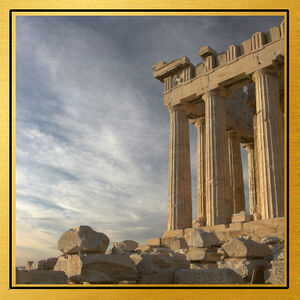| Greek Foundation of Classical Antiquity | |
| Period | Classical Antiquity |
| Dates | 539-371 BC |
| Chronology | |
| Preceded by Cradles of Civilisation |
Followed by Age of Alexander |
| “ | The unexamined life is not worth living. | ” |
–Socrates | ||
The Greek Foundation of Classical Antiquity lasted from about 539 BC until 371 BC. It began with the rise of the greatest of all the ancient empires yet seen, that of Achaemenid Persia, whose long struggle with Ancient Greek would become legendary. It then ended with the disastrous Peloponnesian War, which was to break the back of classical Greece, and pave the way for the rise of Macedonia.
The role of the Greeks was pre-eminent in making the "Classical" world, and with them its story must begin. Around 800 BC, the Aegean had begun to settle into a new social and political structure; a loose collection of city-states united only by a shared language and culture. By the standards of its contemporaries, early Greece was a rapidly changing society: population pressure spurred a great age of Greek colonization; growing prosperity prompted a new style of warfare, Hoplite citizen-soldiers, who were to be for centuries the backbone of Greek armies; and class struggles transformed hereditary kings supported by aristocracies into various forms of collective rule, including nascent democracies. Athens and Sparta were to quarrel fatally in the fifth-century, and this has led them to be seen as the poles of the political world of Ancient Greece. They were not, of course, the only models available. Herein lies one of the secrets of the Greek achievement. It could draw upon a rich variety of political experience, providing the data for the first systematic reflections upon the great problems of government, law, duty, and obligation, which have exercised men’s minds ever since.
The Greek struggle with Persia was the climax of the early history of Greece, and the inauguration of its Classical Age. Because later Greeks made so much of this long conflict, it is easy to lose sight of the many thing they had once found to admire. Cyrus the Great founded the largest empire the world had seen until that time, spanning three continents; Europe, Asia and Africa. It is best known for merging Persian, Iranian, Lydian, Babylonian, Israelite, Egyptian, Indian, and Greek cultures relatively harmoniously; for freeing the Jews from their "Babylonian captivity"; for its successful model of a centralized administration; for building infrastructure such as roads and postal systems; and for developing one of the first large, professional standing armies. Because of its long endurance, Persia influenced the language, religion, architecture, philosophy, law, and government structure of all future Near Eastern empires.
The passage from the Greek glorious days of victory over Persia, to the Persians' almost effortless recouping of their losses thanks to Greek division in the Peloponnesian Wars, is a historical drama which grips the imagination; was a real opportunity to unite Greece squandered after Marathon, Thermopylae, and Salamis? But the fundamental reason why such intense interest has been given to these few centuries lies in the extraordinary cultural legacy of Classical Greece; it is an achievement of the mind that constitutes their major claim on our attention. Every schoolboy used to know the names of Homer, Pythagoras, Euclid, Archimedes, Socrates, Plato, and Aristotle. In the end, the Greeks are remembered as poets and philosophers, and their views - on politics, sculpture, architecture, philosophy, mathematics, astronomy, medicine, history, and literature - were to dominate both Europe and the Islamic world until the sixteenth century.
History[]
Emergence of Greek City-States[]
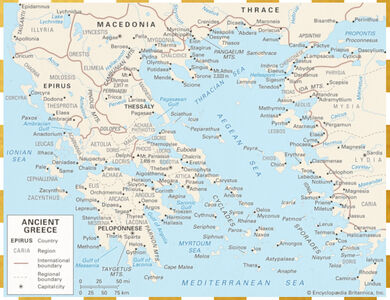
In the early eighth century BC, Greece began to emerge from the dark ages, which had hidden events and processes since the Bronze Age Collapse. There is even a date or two, one of which was important in the development of Greek self-consciousness. In 776 BC, it is said, the first Olympic Games were held; a religious festival, held at the temple of Zeus in the city of Olympia. Later Greeks would count from that year as we now count from the birth of Christ. The people who gathered for that first festival games recognized by doing so that they shared a culture. Its basis was, first and foremost, a common language; whether descended from Mycenaeans or Dorians, they all spoke Greek. The great festival games were occasions to which only Greek-speakers were admitted; a language that now acquired the definition which comes from being written down, using an adaptation of Phoenician script. Important to the understanding of this period is the powerful belief in the Greeks as three distinct clusters. The old Mycenaean cities had buckled, three hundred years earlier, in the face of the "Dorian invasion", but survived on the peninsula known as Attica (the land around Athens). Other Mycenaeans, driven from their homeland, had sailed across the Aegean See over to the coast of Anatolia (the major part of modern Turkey), where the mixture of Greek and Near Eastern ways resulted in a distinctive culture which we call Ionian. Meanwhile, the Dorians had established their own strongholds down on the Peloponnesian peninsula. All three groups then spread across the nearby islands. The Doric dialect was distinct from the Mycenaean dialect, and both were different from the Ionian version. As the Dorian disruption receded into distant memory, the Greek peninsula entered into a period of relative peace, in which the Greeks were more likely to act as allies than enemies. Sometime around 800 BC, this growing sense of a common cultural identity led to the weaving together of a mass of different oral traditions (mainly Mycenaean) into two related epic poems, which would soon be claimed as the heritage of all Greeks: the Iliad and the Odyssey. Later Greeks attributed these masterpieces to one Ionian poet, Homer. Much time and ink have been spent on arguments about who he was (or wasn't); theories range from a single genius to a whole school of poets writing under a single pen-name. For our purpose, the important point is that the stories of the Siege of Troy, and the heroes who fought there, offered the Mycenaeans and Dorians and Ionians a mythical shared past. In the Iliad, for the first time, we come across a word for those who lived outside Greece. Homer calls them barbaro-phonoi (“strange speakers.”) or barbarians; though the word was less dismissive than it is in modern usage. It was a simple division of all peoples into two; human nature was either Greek or non-Greek. The other foundation of Greek identity was religion. Perhaps Homer did as much as anyone to order the enormously complex Greek pantheon, an amalgam of myths from many communities over a wide area; some of them imported from the Near East and Egypt. It is a religious system very different from that of other civilisations in its ultimately humanizing tendency. The Greek gods and goddesses, for all their supernatural power, behaved in postures all too human, and showed very human vices. The Iliad and Odyssey present the gods trying to outdo one another; Poseidon harries the hero Odysseus on his way home, while Athena takes his side, A later Greek philosopher grumbled that Homer "attributed to the gods everything that is disgraceful and blameworthy among men: theft, adultery and deceit". Human though Homer’s gods might be, the Greeks also had a deep respect for the occult and mysterious, especially oracles. The most famous of these by far was the oracles of Apollo at Delphi (though there were many others), the sources of respected, if enigmatic, advice. Together with language, a shared heritage of religion and myth was the most important constituent of being Greek, always and supremely a matter of common Hellenic culture. They belonged, they felt more and more,, to "Hellas". It may surprise you, but the Greeks did not call themselves "Greeks"; that name was given them centuries later by the Romans. The word they would have used was Hellenes; which derives from Hellen, the mythological ancestor of all true Greeks.
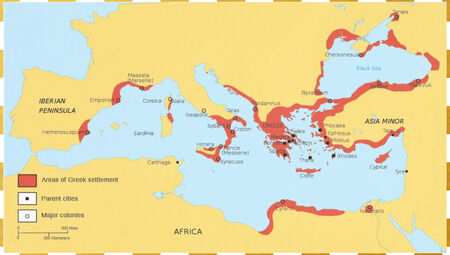
The strength of Greek identity was never politically effective. It is in the geographical setting of Greek history - which was not what we now call Greece, but rather the whole Aegean - that much of the explanation must be sought. For the most part, agriculture was confined to narrow strips of land, framed by rocky mountains, forested hills, or the sea. This made possible a cluster of economically viable cities, and communication between them was usually difficult. Consequently, the Greek cities were independent city-states that tended to look outwards to the sea; none of them, after all, lived more than forty miles from it. This inclination was intensified, in the eighth century BC, by population pressure; perhaps growing as much as threefold between 800 and 700 BC. These people needed more grain, more metals, and especially more land. Land was traditionally divided between all of the sons, meaning that any family’s holdings shrank inexorably over time. Ultimately, this led to a great age of colonization. Around 775 BC or so, the Greek cities of Chalcis and Eretria sent a joint expedition to build a colony at Pithecusae (the isle of Ischia), on a little body of water known today as the Bay of Naples. Around 740 BC, these same two cities began to force-out all of their younger sons as colonists, founding no fewer than five cities (Cumae, Naxus, Lentini, Catana, and Rhegium) over the next twenty years. Not to be outdone, around 733 BC, the city of Corinth put an aristocrat named Archias at the head of an expedition to Sicily, where he founded a colony called Syracuse. The setters who ventured out to these new Greek cities had to give-up their citizenship in their own “mother city”, the home city from which they came. Their entire identity as Greeks now rested on their ability to establish a Greek enclave in foreign lands; they planted Greek grain, ate Greek food, built Greek temples, told Greek tales, and sent their delegations to the Greek games. By the end of the colonization period, probably around 630 BC, the Greek world stretched far beyond the Aegean; Massalia (modern-day Marseille), in the west, became the base for a series of further colonies as far away as Spain; in the east, as many as seventy colonies were planted around the Black Sea, among the Byzantium; and a few colonies were even founded on the Libya, to the south. Some Greek colonies seem to be where they are because of their farming potential; some because of trade; and others to access metals they could not find in Greece. Nor were colonists the only agents diffusing Greek ways; and teaching Greece about the outside world. From the sixth century onwards, a considerable number of Greek mercenaries could be found in the service of foreign kings. Historical records show us that, when the Persians took Egypt in 525 BC, Greeks fought on both side. Some of these men must have returned to the Aegean, bringing with them new ideas and impressions. By then, a process of cultural interplay was working both ways, for Greece was both pupil and teacher. The Lydians of western Anatolia, for example, kingdom of the legendary Midas (who turned everything he touched into gold), were Hellenized by contact with the Ionian Greeks; they took its art from them, and, perhaps more importantly, its alphabet. All these developments were to have important social and political repercussions on the Greek homeland.

Each hoplite, the famous Greek citizen-soldier, provided his own equipment. He typically wore bronze armour (helmet, body-armour, and greaves), and carried a round shield. His main weapon was the spear, which he did not throw, but thrust and stabbed in the mêlée which followed a charge by an ordered formation (the Greek phalanx) whose weight gave it effect. They depended completely on their power to act as a disciplined unit, because each hoplite was protected partly by the shield of his neighbour on his right-hand side. The Spartans were particularly admired for keeping an ordered line in the preliminary charge, and for retaining cohesion once the scrimmage had begun.
By the standards of its contemporaries, early Greek civilization was a rapidly changing society. One important development, towards the end of the seventh century, was an upsurge of trade with the non-Greek world. Part of the evidence is an increased circulation of silver. The Lydians had been the first to strike true coins - tokens of standard weight and imprint - around 650 BC. It was quickly adopted by Greek communities, spreading as far west as Sicily before 525 BC; only Sparta resisted its introduction. Commerce became a possible answer to land shortage at home. Athens assured the foreign grain she needed by specializing in the output of great quantities of pottery and olive oil; Chois became known for high quality wine. All this new commercial wealth began a revolution, both military and political. The old Greek ideal of warfare had been a military aristocracy, few in number and preoccupied with personal courage, riding to the field of battle to confront their equals, while their less well-armed inferiors brawled about them. The new commercial class could afford the armour and arms which provided a more effective approach; "hoplites", the regiments of heavy-armed infantrymen who were to be the backbone of Greek armies for two centuries. They would prevail by disciplined cohesion, rather than by individual derring-do. This implied some sort of regular training, as well as a social widening of the warrior class. As more men came to share in the power which comes from exercising military force, they battered away at the existing élites to get admission to political power. It was in these years that the Greeks invented politics; the notion of making collective decisions by debate in a public setting. The magnitude of what they did lives on in the language we still use, for the word "politics" derived from the Greek word for city, polis. By the beginning of historical times, most Greek cities seem to have been dominated by small groups of aristocratic families, who had already supplanted the kings themselves. Inevitably, they tended to be self-serving and corrupt. In Hesiod's poem Works and Days, composed sometime in the mid-eighth century BC, he longs for a day when men will benefit from their own labour, rather than seeing it stolen by the more powerful. The new men sought to replace these aristocratic oligarchies with governments less respectful of traditional interests; the result was an age of what the Greeks called "tyrants". The earliest example was Cypselus, who seized power in Corinth in a coup in 655 BC; he was followed by a series of others throughout the peninsula. The later sinister connotations of the word tyrant did not then exist; they were not necessarily cruel, though they tended to be autocratic in order to keep power. They brought peace to social struggles largely arising from limited land. This phenomenon did not last; few tyrannies lasted into a second generations. In the sixth century, the current turned towards collective government; oligarchies, constitutional governments, even nascent democracies began to emerge almost everywhere. It is risky to generalize about such matters. There were more than a hundred-and-fifty Greek cities, and about many of them we know nothing; of the rest, we know only a little. The detail of what went on can only judge by the two cities we know most about; Sparta and Athens.
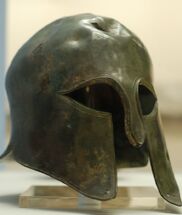
Spartan helmet on display at the British Museum. The helmet has been damaged with the top having sustained a blow, presumably from battle.
The city of Sparta, in the centre of the Peloponnese, took a different approach to the problem of population growth. They were Dorians who had settled on Mycenaean ruins, and built a city of their own on the Eurotas river. The river was useful as a water supply, but shallow, rocky, and unnavigable; so the Spartans had no ships. While other Greek cities were sending out boatloads of colonists, the Spartans armed themselves, crossed over the mountain range to the west, and conquered the neighbouring city of Messenia. It was not an easy conquest; the Spartan poet Tyrtaeus says that the war lasted twenty years. But by 630 BC, Messenia had become a subject city, and Sparta was more than a city; it was a little kingdom. In this Spartan kingdom, the conquered Messenians become a whole class of slaves (helots), who grew all the food for their masters on terms as harsh as anything found in ancient times. The Spartans themselves became the aristocracy, a master race of warrior men and mothers of warriors. There was no risk of a new commercial class developing, for there is no commerce; even coins were prohibited until the third century BC. Sparta had one peculiarity not found anywhere else in the ancient world; two kings. descendants of the legendary twin brothers who had founded Sparta. Even with two kings playing tug-of-war with power, the Spartans kept on shoring themselves up against unchallenged monarchy. According to Aristotelian political theory, any form of government holds three primary powers: the military power to declare war; the judicial power to make and enforce laws; and the religious power to maintain good relationships with the gods. In Sparta, the kings held all three powers; but with limitations. They had the unilateral right to declare war, but one king must lead the army, be the first into the charge, and the last to retreat; which no doubt kept them from fighting needless wars. The judicial power for the kings gradually shrank, until, by the fifth century BC, almost all lawmaking fell to a council of twenty-eight elders (the ephors). And finally, the kings were high priests responsible, in partucular, for maintaining communication with the oracle of Delphi, but up to four ephors must accompany them to hear her pronouncements; omens exercised great authority in Sparta. There was also a Spartan public assembly of all male citizens over thirty, called the Ekklesia, but its power was limited to electing member to the ephors. Even there, Spartans were not permitted to debate; the airing of views was not considered useful. But the real power in Sparta was neither the kings, nor the council of Ephors. The Spartan state was ruled by a strict and unwritten code of laws that governed every aspect of life. Our knowledge of them comes mostly from Plutarch (d. 119 BC), writing centuries later. Even allowing for distortion, these laws have long fascinated and bemused. Children did not belong to their families, but to the state; the Ephors had the right to inspected each newborn, giving it permission to live, or else to die on the “place of exposure”, a wasteland in the mountains. At the age of seven, boys were assigned to the Agoge, learning to fight, to forage for food, and cultivating ready obedience. Girls too, who were the future Spartan mothers, seem to have gone through a fairly rigorous education, with more emphasis on music, dancing, singing and poetry. In this respect, Sparta was unique; in no other Greek city did girls receive any formal education at all. Adult Spartan men did not live with their families, but the communal dormitories and ate meals in common "messes". In order to prevent greed and envy, they avoided dressing differently, and were not supposed to own silver or gold. Their condition of life was, in a word, "spartan", reflecting a sort of militarized egalitarianism often admired by later puritans. These laws were unwritten. The semi-mythical Spartan lawgiver Lycurgus explains, "Laws only work if they are written on the character and heart of the citizen"; the Spartans themselves continually watched each other for violations. Generations later, one Spartan king tried to explain to Persian king Xerxes how this had affected the Spartan character; "Although they’re free, they’re not entirely free. Their master is the law, and they’re far more afraid of that than your men are of you". Yet a cloud hung over Sparta, and it was remarked by other Greeks; the fear of a Helot revolt. It hobbled Spartan ambition. Increasingly, they feared to have their army far from home. Sparta was always on the alert and the enemy was at home.
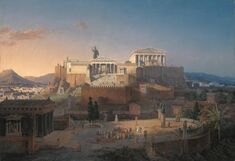
The Acropolis of Athens by Leo von Klenze (1846). The leading position of Athens may well have resulted from its secure stronghold on the Acropolis, its central location in the Greek world, and its access to the sea.
To the north, across the land-bridge that connected the Peloponnese to the rest of Greece, Athens had gone one further than Sparta by getting rid of its kings altogether. In very ancient times, the city had been ruled by the mythological Theseus, whose palace stood on the Acropolis. During the dark ages, many of its inhabitant had wandered east to become part of the Ionian settlements along the Anatolian coast. But some remained to keep the city alive. The happenings in the years before 650 BC are preserved only in fragmentary accounts written centuries later. Pieced together, they show a slow and crooked path away from monarchy towards a sort of aristocratic oligarchy. By the beginning of historical times, the role of Athenian king had been renamed: it still passed from father to son, still lasted a lifetime, but it was now called an archon, or chief justice. Another official, the polemarch, was given control of the military, while a third carried out priestly functions. Thirteen archons later, these offices were filled from the wealthier landowning class by election every ten years; after 683 BC, the offices were held for only a single year. They were elected by an assembly of ex-archons (the Areiopagos), other wealthy landowners; which also served as a council advising the archons. Like Sparta, Athens had grown to be something larger than a city, bringing the other towns of the tiny Attica peninsula under its control. This process, which seems to have happened more or less peacefully, created the largest and wealthiest state on the Greek mainland. But it also created a larger class of people excluded from political life. In 632 BC, a would-be "tyrant" named Cylon attempted to seize power in Athens. However, the coup was opposed by the people of Athens; Cylon himself escaped, but his followers were besieged in Athena's temple on the Acropolis. They were persuaded by the archons to leave the temple and stand trial, after being assured that their lives would be spared. But when the conspirators began to stagger out, the archons murdered them anyway; a dreadful sacrilege, since the men had been promised protection at the goddess's temple. For this crime, the archons were all exiled from the city. But the unrest that followed showed that Athens was not at peace under its oligarchic system. In response, the Athenians did what the Spartans had refused to do: to set-down the law in writing. The man who took on the job was an elected archon named Draco (d. 600 BC). His law code was remarkable not for what it outlawed (murder, theft, adultery), but for the penalty of death which was attached to so many crimes. However, these "Draconian" laws ultimately failed to quell the conflict between rich and poor. In 594 BC, another archon named Solon (d. 560 BC) made a second stab at a fair law code. His first reforms dealt with relief for impoverished peasants. Not only did the aristocratic families hold nearly all political power, they own most of the land. Meanwhile, the free smallholders were increasingly falling into debt in tough years. If they mortgaged their land, a pillar was conspicuously placed upon it. The farmer must then pay a sixth of all his produce to his creditor; if he defaulted on his payments, he would be enslaved. Solon boldly removed all the pillars (thereby cancelling their debts), and, at the same time, made it illegal for anyone to be enslaved by a creditor. Having eased the burden of the poor, he attempted to open-up the political structures of Athens. Under his reforms, a new popular assembly (the Ekklesia), which was open to every male citizens, assumed the role of electing the archons; which was not quite as democratic as it sounds, since to be a citizen, a man must own land. These archons were assisted by a new advisory-body of four-hundred (the boule). The old Areopagus, which formerly had these roles, remained but now became only a law court for certain matters. All this didn't please the rich. Nor did it please the poor, who had hoped for more; not just debt cancellation, but land redistribution. Solon's moderate reforms pointed clearly to the future, but did not at once legislate Athens to peace.
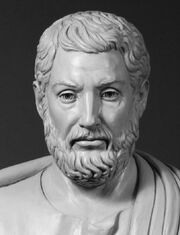
Cleisthenes is regarded as the "Father of Athenian Democracy". His reforms gave all the male citizens, regardless of wealth, a voice in political decisions. Athenian democracy would provide the stability necessary to make Athens the cultural and intellectual center of the ancient world.
After Solon, the Athenians divided into three squabbling factions, each with its own nickname; the Men of the Coast, the smallholders who supported his reforms; the Men of the Plain, the old aristocratic families who wanted all power back in their own hands; and the Men of the Hills, the landless poor who wanted the same privileges as everyone else. This third group was the wildest, and their leader, Peisistratus (d. 527 BC), proved the most ruthless. In 560 BC, he launched a coup, and seized power in Athens. Although he lost and regained power twice, Peisistratus ruled as a "tyrant" for thirty years of relative peace and prosperity. He did not hesitate to confront the aristocracy, confiscating their lands and giving them to the landless. He also promoted Athens as a cultural centre (in part to enhanced his own prestige); new festivals were inaugurated such as the Panathenaic Games honouring Athena (who now became patron goddess of the city), as well as the Dionysia honouring Dionysus, the god of wine and pleasure. On his death, Peisistratus was even succeeded by his eldest son Hippias, in quite king-like fashion. This did not cause any great heartburning, until a family crisis ensued. Hippias' younger brother was murdered in a private squabble with a former lover named Harmodius. Although Harmodius was killed on the spot, his accomplice Aristogeiton was duly arrested. An enraged Hippias had the young man tortured for an unspeakably long time, until Aristogeiton, maddened by pain, accused all sorts of Athenians of plotting to seize power. Hippias then began a purge of everyone named, and anyone else who got in his way. The Athenians were delivered from this mess by an unlikely saviour; the Spartan king. This king, Cleomenes (d. 590 BC). marched on the city not out of love, but out of fear; Athens was now the biggest barrier left between Sparta and the advancing Persian juggernaut, so could not be allowed to fall into anarchy. This intervention by the Spartans only served to hasten the progress towards democracy. With the tyrant ousted, it took some time for the Athenians to settle affairs with the various factions. When the dust settled in 510 BC, an aristocrat Cleisthenes (d. 508 BC) was appointed by popular support to reform the formerly tyrant-dominated government. Under Cleisthenes, at last, began to operated the fully fledged Athenian democracy. The popular assembly (the Ecclesia) became the de jure mechanism of government; it had the final say on legislation, and the right to call officials to account after their term of office. But his boldest reform was a restructuring of Athenian political loyalties. Until now, every Athenian citizen was a member of one of four long-established tribes, based on links of kinship. Inevitably, aristocratic families wielded great influence within them. To break-up these highborn power networks, Cleisthenes replaced the tribes with ten abstract units of electoral democracy; Attica, the territory of the Athenians, was divided into three regions - the city itself, the coastal plain, and the inland hills; each of these was subdivided into ten smaller regions called demes, making thirty in all; and each electoral unit consisted of one demes from the city, one from the plain, and one from the hills, in order to prevent the emergence of sectional factions - city-dwellers against country-folk, farmers against merchants. This was a coldly rational idea; the astonishing thing is that it worked. The ten new "tribes" soon become the heart of political life. A new custom was also introduced at this time; "ostracism". Any citizen of Athens could be exiled from the city for ten years, should a plurality of his compatriots write his name on pieces of pottery (called ostraka) which were used as ballots. The initial trend was to vote for a citizen deemed a threat to democracy; a would-be tyrant. But soon anyone judged to have too much power in the city tended to be targeted for ostracism; “Ostracism was not a means of punishing a crime," Plutarch remarks, "but a way of relieving and assuaging envy ... an emotion which finds its pleasure in humbling outstanding men”. Nonetheless, Athenian democracy would provide the stability necessary to make Athens the cultural and intellectual centre of the Greek world.
Sparta and Athens were to quarrel fatally in the fifth century BC, and this has led them to be seen always as the political poles of the Greek world. They were not, of course, the only models available. And herein lies one of the secrets of Greek achievement. It could draw upon a richness of political experience far greater than anything seen in the world until this time. This provided the data for the first systematic reflections upon the great problems of government, law, duty, and obligation, which have exercised men’s minds ever since. The Greek world had frontiers where conflict was likely. In the west, they once seemed to be pushing ahead in an almost limitless expansion, but this came to an end around 550 BC, when the Carthaginians and Etruscans prescribed that limit. In the east, the Greek cities on the Anatolian coast had often been at loggerheads with their neighbours. They suffered much against the Lydians, until they came to terms with Croesus of legendary wealth, and paid him tribute. Nonetheess, an even more formidable opponent loomed even further east; Persia.
Rise of Persia[]

The Holy Fire at the Zoroastrian Temple of Yazd in Iran. Of its spiritual founder, Zoroaster, we know almost nothing except his achievement, and that he was believed to have experienced divine revelations. There is no consensus even on when Zoroaster lived and taught. While most scholar consider a date around 1000 BC to be the most likely, dates between 1500 BC and 500 BC have also been proposed.
The starting-point of Ancient Persia is, once again, a great migration. On the high plateau, which is the heart of modern Iran, there were settlements in the fifth century BC; the city of Susa, which would later become part of Elam, was founded around 4400 BC. But the word "Iran" in its oldest form means "land of the Aryans", These wandering peoples are thought to have arrived in the region at some point in the second century BC. In Iran, as in India, the impact of the Aryans was to prove ineffaceable and founded a long-enduring tradition. They brought with them a polytheistic religion - closely related to the Vedic belief system of India - in which many gods were presided over by a chief deity, Ahura Mazda (god of wisdom). At some point before 1000 BC, the priest-turned-prophet Zoroaster claimed divine revelation, and conceived of a religion that has been called monotheism; Zoroastrianism. He taught his disciples that there was only one true god, Ahura Mazda; the other gods, such as Mithra (god of justice) and Anahita (goddess of fertility), were demoted to "emanations" of Ahura Mazda. The presence of evil in the world, according to Zoroaster, reflected as an eternal struggle between Ahura Mazda, and an equally powerful opposing force, Angra Mainyu; good and evil, light and darkness, truth and deceit. He rejected all but one ritual practiced by the Aryans, keeping only the veneration of fire; so the holy fire became, in Zoroastrianism, the symbol of the divine. It is not known how rapidly or widely this creed spread through Iran, but it was eventually adopted as the official religion of the various Persian empires. It would influence not only Judaism but Christianity and Island; the notions of angels and demons, and heaven and hell, both came from Zoroaster.
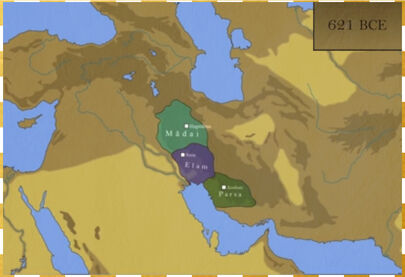
The Ancient Iranians (as we may now call them) were made up of many tribes, of which two - especially vigorous and powerful - have been remembered by their Biblical names as the Medes and the Persians. It was at first the Medes (728-549 BC) who play the dominant role. They populated the region of north-west Iran, where they were often at loggerheads with their powerful western neighbours, the Neo-Assyrian Empire, Sometime around 728 BC, the Median tribe managed to coalesce into a kingdom. According to tradition, a clan judge named Deioces gained a reputation for fairness and integrity that spread among the other clans, until they proclaimed him leader of them all. Considered the first king and lawgiver in Iranian history, Deioces (728-678) is credited with founding the city of Ecbatana as his capital; one of the most startling cities of ancient times. It was built on the eastern slopes of Mount Orontes, and surrounded by seven concentric walls, each painted with bright colours; the outer wall white, the next black, the next scarlet, the next blue, and then orange; and the last two walls were gilded respectively with silver and gold. Deioces was succeeded by his son Phraortes (675–653 BC), who built on his father's achievement. He subjugated the nearby Persians, who had established themselves in the old lands of Elam (now south-western Iran). Phraortes then set his sights on the strife-riven Assyrian Empire, which had dominated the Near East for so long. This proved a miscalculation. The Assyrians had secure their northern border by alliance with a nomadic tribal confederation on the Pontic steppe, north of the Black Sea. These Scythians poured down into western Iran from the Caucasus Mountains; the first major eruption a new force in world history, nomads straight out of Central Asia, fighting with the bow from horseback. Not only were the Medes defeated, but Phraortes himself was killed, and both Medes and Persia came under Scythian dominance. Some twenty-eight years later, a son of the dead Phraortes named Cyarxes (d. 585 BC) led a revolt. According to Herodotus, he invited the Scythian court to a banquet on his estate, got them thoroughly drunk, and then had them all killed. At once, Cyarxes reorganized the army in preparation for war; whereas the Medes had fought as militias divided into tribal clan, he instituted a regular army organised by speciality (foot soldiers, archers, and cavalry). All around him lay nothing but chaos; to the north, the disorganized and leaderless Scythians, and to the west, a dying Neo-Assyrian Empire. Cyarxes knew an opportunity when he saw one, and offered his friendship to Neo-Babylonian king Nabopolassar, who accepted. They agreed to push Assyria over the edge, and divided its territory between them; an agreement sealed by the marriage of Cyarxes' daughter to the Babylonian crown prince, Nebuchadnezzar II, eldest son of Nabopolassar. In 612 BC, the newfound alliance sacked and destroyed Nineveh, bringing an abrupt end to the story of Assyria. While the Babylonians became heirs to all of the Assyrian holdings within Mesopotamia, the Medes share of the spoils were the eastern and northern highland. By the time Jerusalem fell to Nebuchadnezzar in 587 BC, his father-in-law Cyarxes had became embroiled in war with the Lydians, the dominant political power in western Anatolia. For three years, the two armies faced each other across the Halys River, neither able to gain an advantage. Cyarxes had now been king of the Medes and Persians for forty years; he was old, ill, and ready to stop fighting; sealed by another diplomatic marriage between Cyarxes' son Astyages, and a Lydian princess. He died not long after, and Astyages (d. 585 BC) succeeded on the Median throne. Comparatively little is known of his reign, except that he was dethroned by his grandson Cyrus, known to history as Cyrus the Great, founder of the first Persian empire. The ancient sources may be called legend, rather than history. According to the best known account by the Greek historian Herodotus, Cyarxes, king of the Medes and overlord of the Persians, had a prophetic dream, in which a vine grew out of his daughter Mandane's womb and curled itself around his entire kingdom. Fearing the dream, he married her off to a subordinate man; the vassal Persian prince Cambyses (d. 559 BC). The couple soon had a son, Cyrus. When a second dream warned Cyarxes of Mandane's offspring, he sent his chief general Harpagus to kill the infant. However, Harpagus, unwilling to spill royal blood, gave the baby to a shepherd to raise instead. Years later, the inevitable happened; ten-year old Cyrus was discovered play-acting the role of king with the other boys of his village. Astyages was pursuaded to spare the boy, returning him to his parents. Harpagus, however, did not escape punishment; Astyages had the boy murdered; Astyages is said to have fed him his own son at a banquet. This story is clearly a reprisal of the ancient Sargon-Moses trope; a baby in peril, miraculously saved, destined for greatness.
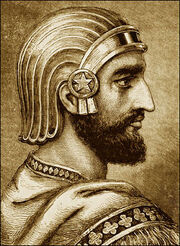
An artistic portrait of Cyrus the Great, based on a relief found on a doorway pillar at Pasargadae, on top of which was inscribed in three languages the sentence, "I am Cyrus the king, an Achaemenian". British historian Charles Freeman suggests that "In scope and extent his achievements, Cyrus ranked far above that of the Macedonian king, Alexander, who was to demolish the his empire in the 320s BC, but fail to provide any stable alternative".
By his own account, generally believed, Cyrus the Great (550–530 BC) was born to the Persian prince Cambyses and the Median princess Mandane. He grew-up the city of Pasargadae (in the modern Iranian province of Fars, on the edge of the Persian Gult), surrounded by his father's family, the Achaemenids; the largest and most powerful of the Persian clans. Upon succeeding his father in 559 BC, Cyrus began planning a revolt against Astyages, his maternal-grandfather. The other Persian clans, who had chafed under Median rule for a century, willingly join him. When Astyages heard of Cyrus's revolt, he ordered his own army to march against the rebels, headed by his chief general Harpagus; who, in Herodotus' account, had long hungered to avenge the "abominable supper". In the first battle, Harpagus defected over to Cyrus' side, along with several other noblemen and a portion of the army. Despite Harpagus' betrayal, the Medes met the rebels in a second battle, led by Astyages personally, but were defeated; the king was taken prisoner, and Cyrus took control of Ecbatana in 550 BC. He spared life of Astyages, and married his daughter to consolidate his power over Medes. This was merely the start of his conquests. The Lydians of western Anatolia were now ruled by Croesus, who had subjugated all of mainland Ionia Greek cities. The lucrative trade carried-out by them across the western Mediterranean had brought him as much wealth as his legendary predecessor Midas, two hundred years earlier. In a likely legend recounted by Herodotus, it was Croesus himself who provoked the war with Cyrus. When his brother-in-law Astyages was overthrown, he consulted the oracle of Delphi, who told him that, if he went to war with Persia, he would "destroy a great empire"; but not which one. The two side met at the Halys River, and fought to a stalemate. Croesus drew back, intending to appeal to his allies for aid, but Cyrus followed too quickly. Before the end of winter, he corner the Lydian army in front of Sardis itself. He scattered the Lydian cavalry by bringing in camels (which frightened the horses), laid siege to the city, and brought down its walls after only fourteen days. Cyrus thought that his men deserved a reward, so he let them plunder the city of its fabled wealth; it is said, a captive Croesus quipped, "It's not my wealth, it’s yours that they’re stealing". The Ionian Greek cities on the Anatolian coast, as vassals of the Lydian king, were incorporated into Persia too. One powerful rival remained: the Neo-Babylonian Empire. After Nebuchadnezzar's forty-three year reign, the empire had fallen into political infighting and turmoil. The man who finally restored order was Nabonidus (556-539 BC), an influential courtier and experienced general. But he had no royal blood. Nor was he of the Babylonian aristocracy. He was from the city of Harran in former Assyria, one of the main cult centres of the mood-god Sin; his long-lived mother was a priestess there. The new king worked to elevate Sîn's status in the empire. For this, he faced hostility from the influential priests of Babylon's national god, Marduk. Nabonidus' solution was drastic; he turned-over governance of Babylon to his adult son Belshazzar, and ruled the empire from the southern city of Tema. This ultimately weakened Babylon, and gave Cyrus his chance. In 540 BC, he began to send troops into skirmishes all along the Babylonian border. These intrusions became serious enough to make Nabonidus return north, back to the heart of his empire. By the time he arrived, Cyrus had already begun marching on Babylon itself. While Nabonidus began preparing for a siege, he ordered his son to head-off the invaders at Opis on the Tigris river, north of Babylon. The Battle of Opis (September 539 BC) was a decisive Persian victory. Arriving at Babylon, Cyrus realized that it could take months, if not years, to starve the well-prepared city into submission. So he formed another strategy, as explained by the Greek mercenary Xenophon. The Euphrates flowed right through the middle of Babylon. Yet the city was well-used to seasonal flooding, so could not be easily flooded. Instead, Cyrus had his engineers divert the waters upstream, and his soldiers marched along the riverbed, under the city-walls, into the unsuspecting city. On 14 October 539 BC, the greatest city of the ancient world fell to the Persians. Undoubtedly, Cyrus had heard the grumblings of Nabonidus' supposed impiety. He rode into the city as Babylon’s liberator, the avenger of Marduk, and was received as such. He had, after all, more Babylonian royal blood than Nabonidus (his great-aunt had been Nebuchadnezzar's queen); ancient thrones had been claimed on less of a blood relationship. And he had his scribes explain, in the famous Cyrus Cylinder (now in the British Musem), how he improved the lives of Babyonian citizens, and restored temples and cut centres. In exactly the same way, Cyrus famously authorized and encouraged the Jews to return to Jerusalem from their "Babylonian captivity". A little more than a year later, the returned exiles laid the foundations of the Second Temple. The prophet Isaiah saw God's hand in Cyrus, naming him "His annointed one"; the only gentile to be so referred. Cyrus' victory was complete. He took over Nebuchadnezzar's great palace as his winter residence, and kept Ecbatana as his summer palace; high on its mountains, it was much more pleasant than the hot Mesopotamian plain during the summer months. The old Persian capital at Pasargadae remained another of his homes. But for the administrative capital of his new empire, he built himself a new city; Persepolis (a little south of Pasargadae). After swallowing Babylon, Cyrus engage in much warfare to consolidate his rule in eastern Iran. He crossed the Hindu Kush, and set-up some sort of supremacy over the northern part of the Indus Valley; the region known as Gandhara (present-day northern Paistan). Only in the north-east did he find it difficult to stabilize his frontiers. There, Cyrus was defeated and killed, fighting across the Oxus river, up into the wilds of Central Asia, against an offshoot of the Scythians: Herodotus calls them the Massagetae. The defeated Persians were allowed to take the remains of the Great King from the battlefield, and inter them in his capital at Pasargadae.
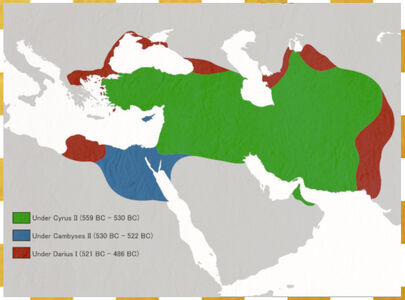
The Achaemenid Persian Empire (550–330 BC) was the largest empire the world had seen until that time. Its style was different from its predecessors; the "newness" of Cyrus’ empire lay in his ability to think of it, not as a Persian nation in which the peoples must be made more Persian, but rather as a patchwork of nations under Persian rule. Unlike the Assyrians, he did not try to destroy national identities. Instead, he portrayed himself as the benevolent "father" of those very identities. The result was a diverse empire, but a powerful one, commanding loyalties of a kind lacking to its predecessors. Large areas knew longer periods of peace under it than they had for centuries, and it was in many ways a beautiful and gentle civilization. Herodotus tells us that there were many things the Persians could do without more easily than the tulip, which we owe to them. Cambyses II (530-522 BC), the eldest son of Cyrus, was crowned as his successor with no reported opposition. He seems to have suffered from an impulse common to many other sons of great men: he wanted to outdo his father. And he set his eye on Egypt. A fleet was crucial for his ambitions. The Persians had no seafaring tradition of their own; but Cambyses had inherited an empire that stretched all along the Mediterranean coast. So he built himself a fleet using the combined skills of the Ionian Greeks and and Phoenicians, two cultures who had been on the water since the beginning of their history. By the sixth century BC, no true navy had existed either in Greece or Egypt. Persia became the first empire, under Cambyses, to inaugurate and deploy a regular imperial navy. Four years after his coronation, Cambyses' fledgling navy began its journey down the coast, while the Persian army marched across the Sinai desert towards the Egyptian frontier. Amasis II (570–526 BC) was on the Egyptian throne when word came down of the approaching invasion. Amasis readied his own forces at Pelusium, an important fortress in the eastern extremes of the Nile Delta. But he was already in his seventies and had led a long and very busy life. Before Cambyses could arrive, Amasis died. This was a bit of very good luck for the Persians, since Amasis's son Psammetichus III was not a gifted general. As soon as the Battle of Pelusium (May 525 BC) began to turn against the Egyptians, Psammetichus pulled them back all the way to Memphis. This gave the Persians virtually free access to the waterways of the Delta, allowing them to besiege Memphis both by land and by sea. We have no details of the resistance that followed, but Psammetichus was soon forced to surrender. He had been pharaoh for less than a year. Cambyses now styled himself pharaoh of Egypt, made sacrifices to the Egyptian gods, and used propaganda to portray himself as a liberator; a now familiar strategy. The new pharaoh did not spend long in Egypt; he put a governor in charge, and hurriedly left to take care of other business. But his tenure was a short one. Three years after his Egyptian conquest, Cambyses died suddenly, mysteriously, and without an heir.
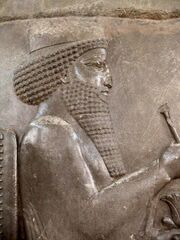
Darius the Great, from the central relief of the northern stairs in the great hall at Persepolis.
The ancient sources surrounding the ascension of Darius the Great (522-486 BC) to the Persian throne are so contradictory that any reconstruction of the events is uncertain. Herodotus repeats a story created by Darius to justify his own usurpation which portrays Cambyses as a cruel tyrant. Before his Egyptian campaign, Cambyses had secretly assassinated his own younger brother Bardiya. In his absence from the capital, however, a pretender who claimed to be Bardiya attempted to seize the Persian throne; as the assassination had been in secret, the Persians still believed him to be alive. Cambyses was over in Syria when he heard the news. He ran for his horse, and accidentally stabbed himself in the thigh while mounting; the wound turned gangrenous and he died three weeks later. With Cambyses dead, the imposter managed to hold onto the Persian throne for seven months. The charade could not go on forever, though. Eventually, a group of seven Persian noblemen, Darius among them, mounted a successful coup against the "fake Bardiya". These seven men then had a very reasonable (and highly unlikely) debate about which of them should be the new king, and concluded that Darius was the natural choice. There are lots of question marks in this story. Modern historians suspect Cambyses died (perhaps naturally, perhaps assassinated), and then the real Bardiya ruled for a few months, until assassinated by Darius. Whatever happened, Darius' reign was one of the most important periods of Persian history. The new king immediately faced rebellions all across the empire; most notably in Babylon, led by a man who claimed to be the son of Nabonidus. These risings, however, were suppressed and quelled in an amazingly brief time. Darius had a new vision for the Persian army. Cyrus had relied on unwieldy masses of conscript soldiers, fighters sent to his as tribute; numbers to overwhelm the enemy by sheer size. Instead, Darius established a professional army, one that would be smaller, but better trained, better fed, and more loyal. It had an elite core of ten-thousand, all of them Persians or Medes. who were bound together so strongly that they jealously guarded entrance into their own ranks. Herodotus calls them “The Immortals" because there was always exactly ten-thousand men; every killed or seriously wounded member was immediately replaced with a new one. Darius was as remarkable an administrator as a general; a rare combination. He completed the organization of the empire, begun by Cyrus, into twenty provinces (satrapies), which were each assigned a trustworthy governor (satrap), and fixed the annual tribute due from each province.Satraps who did not send the proper amount, or did not keep their provinces in order, were liable to be executed. We get a glimpse of this in the Book of Ezra. The satrap who had the watch over Jerusalem noticed that the construction of the Second Temple (and particularly its outer walls) had progressed to a worrying degree; it looked more like a defensive citadel, than a temple. This satrap, a man named Tattenai, ordered the work to stop until he could report to Darius. The Jews protested that Cyrus had given them permission, but Tattenai was not willing to take the risk. Eventually, Darius did give the Satrap permission to let the building go ahead, but the Biblical account was not sympathetic to Tattenai; a man who no doubt feared the seeds of rebellion and the lose his head. Alongside other innovations in centralized administration, Darius introduced a new uniform coinage, the daric; standardized weights and measures; used a common language, Aramaic (the old lingua franca of Mesopotamia) across its territory; expanded the network of roads; and instituted a postal system, based on relay stations for the change of horses, so that messenges could be conveyed at two-hundred miles a day. While these measures united the diverse peoples of the empire, Darius followed Cyrus' example in respecting native faiths and religions. While there is no scholarly consensus on the religious beliefs of his predecessors, Darius in his inscriptions appears as a fervent believer in Zoroastrianism; its introduction as the state religion of Persia is often attributed to him. Darius was the greatest builder of his dynasty, and, during his reign, Persian architecture assumed a style that remained unchanged until the end of the empire. In Susa, the former Elamite capital, he built a new palace complex in the northern part of the city, which became his favourite residence. At Persepolis, in old Persia, Darius founded a new ceremonial capital to replace the old one at Pasargadae. The city was in the end a collective creation; later kings made their own additions, and embodying it with the cosmopolitanism of empire. Assyrian colossi (human-headed bulls and lions) guarded the Gate of All Nations, as they had done in Nineveh. Up the Great Stairway marched stone warriors bearing tribute, carved by Ionian artisans. The many decorative columns, and rock tomb cut into the cliff face recall Egypt. These monuments fittingly express the continuing diversity and tolerance of Persian culture. After securing his authority over the existing empire, Darius turned his eyes to new frontiers. In the east, he hoped to conquer the Indus river valley. The Persians had reach the river under Cyrus, but he had no idea where it went. So he hired an Ionian sailor named Skylax to lead an expedition to explore the region. He is said to have sailed down the river to the sea, and then sailed west, around the Arabian Peninsula, to reach Suez on the Red Sea. Darius then conquered the lands from Gandhara to modern Karachi. The Persian Empire, bulging-out in almost all directions, made little progress to the north-west, ultimately provoing the Greco-Persian War.
Greco-Persian Wars[]
The Greco-Persian Wars (499-479 BC) is the climax of the early history of Ancient Greece, and the inauguration of its Classical Age. Because the Greeks made so much of their long struggle with the Persians, it is easy to lose sight of the many ties that linked the two belligerents. The Persian fleet - and to a lessor extent the Persian army - launched against them had thousands of Greeks, mainly from Ionia, serving in them. Cyrus had employed Greek stone-cutters and sculptors; Darius had a Greek physician. The war itself did as much to create and feed the antagonism; however deep the emotional revulsion proclaimed by the Greeks for a nation which treated its kings like gods. But myths breed future realities, for in the repulse of an Eastern despot by Greek freemen lay the seed of a contrast often to be drawn by later Europeans; the first of many episodes in which Europe confronted Asia and won.
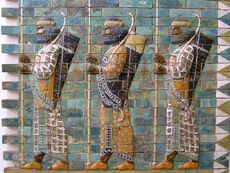
Depiction of Persian soldierss from the Palace of Susa. Their garments match the description by ancient authors of the standing army known as the Immortals. This elite corp of 10,000 was precisely decimal: ten battalions of 1000 were divided into companies of 100, and squads of 10. The armies' tactics emphasised maintaining their distance from the enemy in order to defeat them with their chief weapon; the bow. Along with the elite corp, there were conscript soldiers from allies in the tens of thousands.
The origins of the war lay not with the Greeks, but with the Scythians. These nomads, who still lived north of the Black Sea, had taken advantage of the disorder of Darius' early reign to raid Persian territory. To punish them, Darius did not plan to advance directly across the Caucasus Mountains; rather, he decided to attack the Scythians from the rear. Accordingly, he would lead his troops across the Bosphorus strait into Europe, and then cross the Danube into Scythian territory. In 513 BC, the Persian army began its long march along the new road from Susa all the way to Sardis in Anatolia. Meanwhile, an Ionian Green engineer named Mandrocles had taken the measure of the strait. It was not a particularly impressive expanse of water, but no eastern empire had yet crossed it. At around 720 yard, it was far too wide for a traditional bridge, so Mandrocles designed a pontoon bridge of low, flat-decked boats, roped together; the first in recorded history. Thousands of Persian foot-soldiers and cavalry crossed the bridge, and then march all across Thrace to a narrow place in the Danube, where another pontoon bridge awaited. The Greek cities of Thrace made no attempt to block the advance; they were afraid of the Scythians too. The Scythians did not line up in opposition. Instead, they retreated constantly before the Persians, while harassing the enemy and systematically destroying laying waste to the countryside. Darius pushed deep into Scythian lands, where there were no cities to conquer and no supplies to forage. But he was never able to bring them to a pitched battle. Finally, the Great King halted the march at the banks of the Volga; his entire army headed back to the Danube, and, over the pontoon bridge, into Thrace. Despite the evading tactics, Darius' campaign was enough to force the Scythians to respect Persian power. But he would not leave without spoils. Darius himself returned to Sardis, but left the army to a trusted general named Megabazus, with orders to conquer Thrace. The Thracian Greek cities, which had hoped for deliverance from the Scythian threat, now found themselves falling, one by one, under Persian rule. Megabazus was a capable general, but his task was made easier by the fractured nature of Thrace; each city had its own ruler, its own army, and no common purpose. After turning Thrace into a new Persian satrapy, Megabazus set his eyes on Macedonia. The Macedonians stood between the Thracian colonies and the city-states of Greece proper; and differed from both. Their cities all belonged to a single kingdom, ruled by a single king. In 510 BC, the year that the Persians appeared on the horizon, its king was Amyntas (d. 498 BC). Amyntas, seeing a well-conquered Thrace behind them, decided at once that resistance was futile. In keeping with Persian practice, Megabazus dispatched seven envoys to demand "earth and water", symbolizing dominance over the land and sea of a subject land. And Amyntas agreed. This alliance would turn out to be very good indeed for Macedonia; neither Greeks nor nomads troubled her borders, since to do so would risk Persian wrath. With Macedon now a Persian ally, there was little barrier now between Persian ambitions and the Greek peninsula.
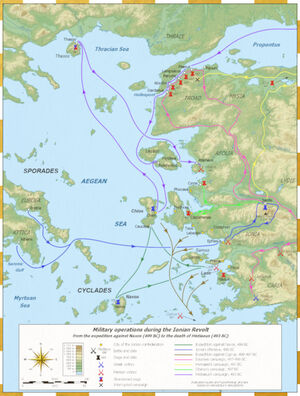
At this point, there was something of a pause, until a troublemaker provoked a direct confrontation between Greece and Persia. He was Aristagorus (d. 496 BC), a "tyrant" who had long dominated the Ionian Greek city of Miletus, on the edge of Persian ruled Anatolia. The Persians found the Ionians difficult to control, because there was no aristocracy to help them rule, only a fractious populace; so they tended to sponsor a tyrant in each Ionian city. Aristagorus was an ambitious man, who fancied ruling a mini-empire. He went the the Persian provincial governor (satrap) at Sardis, and offered to conquer the nearby islands on behalf of Persia, if the Persians would fund his campaign. With the plan agreed, Aristagorus set sail for his first target, the island of Naxos; the inhabitants hauled all of their provisions inside the city, and withstood a four month siege, until Aristagorus ran-out of Persian money. Aristagorus was now caught in a bind; the Persians would no doubt remove him from power, due to his failure to make good on his promises. In a desperate attempt to save himself, he turned on a dime from pro-Persian to anti-Persian. He would lead the Greek cities of Anatolia in an Ionian Revolt (499-493 BC). But he had learned from his Naxos debacle that wars were expensive; he needed strong allies. The first obvious choice was Sparta, the pre-eminent Greek city in matters of war. However, despite Aristagoras's entreaties, the Spartan king Cleomenes (d. 490 BC) not only refused to poke the Persian beast; he first laughed at Aristagoras and then pitched him out of the city. He was better received in Athens. Hippias, the expelled Athenian tyrant, had gone to Persia to seek help in recovering the city. The Athenians granted Aristagoras the help of twenty ships, each carrying perhaps twenty hoplites; its ally Eretria sent five more. The Ionian Revolt began on a high note. Aristagoras and his allies managed to surprise Sardis. The satrap and his troops shut themselves safely into the citadel, but the city (by plan or accident) went up in flames. Darius immediately sent his fast and well-trained army to put down the revolt. When the two armies met near Ephesus, the Greeks were soundly thrashed. After this defeat, the Athenians, seeing no good coming from the revolt, decided to go home But the Ionians had no choice but to fight on; burning Sardis had been a point of no return. They enjoyed some success off-shore. A joint Ionian fleet sailed up and down the coast, collecting allies as they went; Byzantium and Cyprus also rebelled against the Persians. This stymied the Persians until 494 BC, when a large Persian fleet caught-up with their Ionian counterpart just off the coast, near Miletus. The Persians had prepared themselves for a huge encounter, but, as soon as the battle turned against the Greeks, scores of ships lost heart and deserted. Aristagorus himself sailed off to Thrace, where he was killed attempting to seize power in the Greek colony of Amphipolis. The victorious Persians took ferocious revenge on Miletus, the city of the troublemaker. The city was stormed and burned to the ground; its population sold into slavery. Worse was to come.
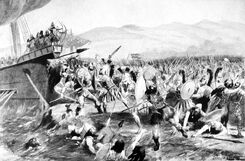
The Battle of Marathon was a watershed in the Greco-Persian Wars, showing the Greeks that the Persian juggernaut could be beaten. The men who fought there were later known as Marathonomachoi, honoured as World War II veterans have been in 20th century. Their victorious general Miltiades came to a thankless end, though. The following year, he led a failed expedition to capture the Persian-held island of Paros. His failure prompted an outcry in Athens, enabling his political rivals to charge him with treason. He was brought to his trial suffering from a grievous leg wound received during the failed campaign, and died in prison, probably of gangrene.
Darius had not forgotten the original Athenian and Eretrian participation in the revolt. In 492 BC, he put his general and son-in-law Mardonius (d. 479 BC) in charge of a two-pronged invasion force; a large army would cross the Bosphorus and march through Thrace and Macedonia down into northern Greece; and a naval fleet would sail across the Aegean to join them for the attack on Athens and Eretria. This first foray into Greece was cut short. The fleet was moving along the Thracian coast, when caught in a violent storm and partly wrecked near the promontory of Mount Athos. It took the Persian navy two years to build. But by 490 BC, Mardonius was back on the job. Herodotus claims that six-hundred warships accompanied perhaps twice as many transports. Even if that is an exaggeration, the fleet was big enough for Mardonius to decide on a purely amphibious operation; a choice force of infantry and cavalry would be carried by the fleet. The Persian fleet proceeded to island-hop across the Aegean, subduing them one by one; Naxos was overrun in a matter of days, suggesting that Aristagorus had not been a particularly competent general. The first major goal was Eretria, on the island of Euboea, north of Attica. The Eretrian strategy was to withdraw within the city-walls, and undergo a siege. However, rather than a passive siege, the Persians vigorously assaulted the walls for six days, with heavy losses on both sides. On the seventh day, two reputable Eretrians betrayed the city to the Persians. With Eretria gone, the Athenians, braced to face the Persian cataclysm, sent a messenger named Pheidippides to Sparta to beg for aid. He is said to have covered the 140 miles in between Athens and Sparta in two days; even if Herodotus exaggerated the time, there is no doubting the distance. But the Spartans were celebrating the festival of Carneia, a sacrosanct period of peace, and could not march until the full moon. It seems very possible that they were attempting to avoid outright war with Persia; whose wrath was directed at those Greek cities which had joined in the Ionian Revolt, and Sparta had declined. Meanwhile, the Athenians had no choice but to face the Persians alone; except for a small force from Plataea. Meanwhile, the Persians headed south down the coast of Attica, landing at the bay of Marathon, roughly twenty-five miles from Athens; they assumed the Athenians would never dare attack them that far away, since it woud leave their city unprotected. But Miltiades (d. 489 BC), the Athenian generals with most experience against the Persians, convinced the Athenians to take that risk; the Battle of Marathon (September 490 BC). The Persians found themselves pinned against the shore. Their strength was cavalry, but they could not use it; the infantry could be disembarked quickly, but disembaring the horses could exposed them to an attack while in disarray. Herodotus tells us that Miltiades arranged the Athenian hoplites in a slightly unorthodox formation, with a thin centre and massed ranks on both wings. And in fact, the Athenian centre broke almost at once. The massed wings, though, quicked routed the Persians on the flanks, before turning inwards to surround the Persian centre. The Persians had no other recourse except to run back towards their ships, pursued by the Greeks. According to Herodotus, the Athenians killed 6,400 Persians at a loss of 192 of their own men, but they did not succeed in getting hold of the Persian ships before they could launch; capturing only seven. Even so, the Battle of Marathon was a staggering Athenian victory; the Spartans arrived in time to help count the dead.

A bronze statue of the Spartan king Leonidas, erected at Thermopylae in 1955. An inscription reads simply "Come and take them", which was Leonidas' laconic reply when Xerxes offered to spare the lives of the Spartans if they gave up their arms. Even during its decline, Sparta never forgot its laconic wit. An anecdote has it that when Philip II of Macedonia sent an ultimatum saying "If I invade Sparta, you will be destroyed, never to rise again", the Spartans responded with a single word: "if". This is why the English word "laconic" derives from the old Greek name for the Spartans; the Lyconians.
In the immediate aftermath, Darius vowed to raise a second invasion force, which he would lead himself; but he had no time. He fell ill in the fall of 486 BC, and died before winter came; thus leaving the task to his oldest son, Xerxes (486-519 BC). Xerxes had been taking notes on his father’s career. Like Darius, he first faced the opportunistic rebellions that always accompanied a change in the royal house. In Babylon, he dealt with the unrest by dividing the previously large satrapy into smaller sub-units, short-circuiting some of its factionalism. Egypt he reconquered by sheer force of arms, and then abandoned the title of "Pharaoh", carving simply “King of the Persians and the Medes” into inscriptions all over the country. By 484 BC, Xerxes had turned his eyes back to Greece. Patient preparations for his expedition required three years to complete; troops were levied all over the empire; ports set to building a fleet, intended to be the army’s supply line; and massive engineering works were undertaken, including a canal across the peninsula of Mount Athos (to avoid the catastrophe which had struck the expedition of 492 BC), In the fall of 481 BC, Xerxes in person marched his troops to Sardis, where they wintered. In that same year, almost all of the Greek cities joined together in a new league, the Hellenic League, formed specifically for the defence of Greece against the Persians. Little is known about the internal workings of the league, but overall command was conferred on Sparta, Even Athens, whose strengthen was of her fleet, accepted this. Having crossed into Europe in the spring of 480 BC, the Persian army began its march to Greece. The Greeks said, and no doubt believed, that the Persians came in millions; if, as now seems more likely, there were well under a hundred-thousand of them, this was still an overwhelming enough number. They had little faith that the north would stand for very long. The Greeks established their defensive line at Thermopylae, just below the Malian Gulf, where the mountains divided to allow only a narrow pass. This was the only decent way for Xerxes to reach the southern part of the peninsula. Their fleet was drawn up at the north end of Euboea, to prevent the Persians bypassing Thermopylae by sea. There they waited, seven-thousand hoplites from various cities under the Spartan king Leonidas (d. 480 BC). Behind them, Greece was in full preparation for disaster. The Athenians evacuated all their women, children, and old men en masse to the safety of Salamis island. And then Xerxes swept down. For two days, he hurled his best troops into the narrow pass, but the Greek phalanx held firm. The situation appeared to be an impasse; until resolved by treachery. A certain Ephialtes defected to the Persians, and informed Xerses about a hidden mountain track that would bring his troops, unseen, to the other side of the pass. A contingent of 20,000 elite troops, Immortals, took that route during the night. Before dawn, spies brought Leonidas news of the imminent encirclement. Realizing that the battle had already been lost, he ordered all of the Greek forces, except for his personal bodyguard of three-hundred, to retreat back down south. With these last three hundred (along with a few troops from Thebes and Thespia who refused to leave), he fought a delaying action against Xerxes. Athens was doomed, but if the retreating Greeks could reach the Gulf of Corinth, they might still be able to hold the Peloponnese; all that would remain of Greece. The Spartans fought until they were wiped out, selling their lives at a high price. Herodotus writes that the terrified enemy had to be whipped into confronting these Greeks; two of Xerxes’ own brothers were alain. The heroism of the doomed rearguard became an enduring monument to Spartan valour, captured in a famous epitaph inscribed on a column in the pass: “Stranger, go tell the Spartans that here we lie, obedient to our laws”. But Xerxes was unimpressed; he ordered Leonidas’ head impaled on a spike and his body crucified, like an common criminal.
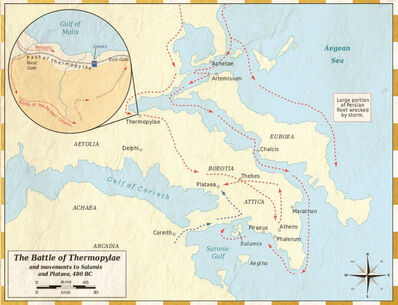
After Thermopylae, it is said, the retreating Greeks had a brief and violent quarrel about what to do next. The Athenians begged the others to make a stand in Attica, to defend their great city. But the rest of the Greeks, recognising that such a broad northern front could not be held, won the day. The entire army retreated back to the narrow land bridge, the Isthmus of Corinth, that connects the Peloponnese peninsula to the rest of mainland Greece; and massed their fleet in the narrow strait separating Attica from Salamis. The Athenians did so under protest; “angry at this betrayal,” Plutarch writes, “and dismayed at being deserted by their allies”, Meanwhile, Xerxes marched in triumph to Athens, and ordered the city to be torched. From the other side of the water, the Athenian refugees on Salamis were forced to watch their great city burn. The next events are chronicled by the playwright Aeschylus, who was there. The Athenian statesman Themistocles (d. 459 BC) knew that time was on the Persian side. The best strategy for Xerxes was a slow and damaging war of attrition; to leave the Greeks penned-up in the Peloponnese, and use his fleet to prevent aid from allies on the outlying islands. So Themistocles sent a message to the Great King feigning to defect; intimating that the fragile Greek alliance was breaking-up, and, if he attacked at once, the dispirited Greeks would scatter. This was exactly the kind of news that Xerxes wanted to hear. He took the bait, and the Persian fleet sailed into the Straits of Salamis; the Battle of Salamis (September, 480 BC). Both sides had very similar ships, the triremes, long thin ships with room for 170 oarsmen, which meant they could knife through the water and ram other ships at high speed. But in the cramped strait, the larger Persian numbers were an active hindrance, as ships struggled to manoeuvre and could not retreat because their lines were several ships deep. By the afternoon, Greek victory was assured and the remaining Persian ships limped back to Pireus, the port of Athens. This defeat need not have been the end for Xerxes, but his rage ruined him. He ordered the captains put to death for cowardice; all Phoenicians, for the Persians raised inland were no sailors. This turned every Phoenician sailor against him, and scores of them sail for home when night fell. With his naval capability in disarray, Xerxes feared that the Greek might sail to the Hellespont and destroy the pontoon bridges. And he decided to go home. He marched back up through Macedonia and Thrace with the bulk of his army, leaving behind a group of troops under his son-in-law Mardonius. In effect, Xerxes was leaving Mardonius to die, to save himself the ignominy of out-and-out retreat. The Persians were still occupying Attica, with an army that more than matched Greek numbers. After a long series of manoeuvres, in which Mardonius tried to lure the Greeks into open terrain where he could use his cavalry, the two sides eventually met near the city of Plataea, on hilly ground. There, at the Battle of Pausanias (August 479 BC), the Persian infantry, once again, proved no match for the heavily armoured Greek hoplites and rigid discipline of the phalanx formation; the Greeks were victorious and Mardonius died on the battlefield. This was a two-pronged attack. The Greek navy had simultaneously pursued the remnants of the Persian fleet across the Aegean, all the way to the coast of Anatolia. The Persians, seeing Greeks behind them, decided not to risk another sea battle; they beached their ships on the shores near Mount Mycale, and lined up to fight on land. At the Battle of Mycale (August 479 BC), the Persians relied on Ionian Greek contingents within their ranks to back them up. But, as the Greeks approached, the Ionians melted away. The Persians stood their ground for a while, but eventually broke and fled. The Greeks chased them all the way back to Sardis, killing as they went; only a handful ever reached the safety of Sardis’ walls. Tradition held that both battles, Plataea and Mycale, took place on the same day. This was the end of the Greco-Persian War. For Xerxes, the sack of Athens was probably enough to allow him to present himself as a returning hero. For Greece, however, the victory not only guaranteed her freedom from foreign rule, but opened an age of huge self-confidence.
Classical Greece[]
Victory over the Persians launched the greatest age in Greek history. Some have spoken of a "Greek Miracle", so high do the achievements of Classical Greece (510-323 BC) appear. Yet those achievements had as their background a political history so poisonous and embittered that it ended in the demise of the very institution which nurtured classical civilization; the city-state. A century and a half later, men were to look back at the heroic days of Mycale and Plataea, and wonder if some great chance to unite Greece as a nation had not then been missed forever.
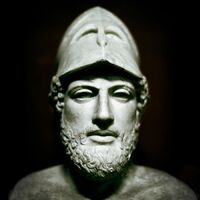
Bust of the Athenian statesman Pericles; a Roman copy of a Greek original from 430 BC. After the Persian war, Pericles came to dominate Athenian politics, and pushed his own plans for Athenian security; these involved maintaining a common Greek fleet, and sailing around to shake money out of the smaller Greek cities.
With the Persians driven back, the newly united Greeks had to decide what to do about the Ionian Greek cities. By siding with the Greeks at Mycale, the Ionians had publicly declared their defiance of Persian rule. And Persian strength was battered but far from dead. Sparta proposed simply evacuating the Ionian cities, and leaving the land to the Persians; they could not “stand guard over Ionia forever”. But the Athenians furiously rejected this; Sparta was blithely abandoning the Ionians, much as they had abandoned their great city during the invasion (content to simply save the Peloponnese). They won the day, convincing the rest that the Persians must be pushed back from the Ionian coast. The Spartans, reluctantly, agreed to stay on; they didn’t want to continue fighting Persia, but nor did they want Athens gaining power as leader of the Hellenic League. And so, the Spartan general Pausanias, hero of Plataea and still overall commander of Greek forces, set sail for their first target, Persian-held Byzantium on the Bosporus, in order to cut-off Persian access into Europe. Byzantium was successfully besieged and captured; but this proved the last time that Sparta and Athens would act as allies. Exactly what happened is unclear; Herodotus' account ends right after Mycale, but later writers added plenty of lurid insinuations. The Athenians were hostile to Pausanias, and wished the Spartan general removed from command, with his Athenian counterpart Themistocles publicly accusing him of conspiring with the enemy; one allegation was that he had released two prisoners who were relations of Xerses (Pausanias insisted that they simply escaped). But this was an accusation that could hardly be ignored, and the Spartans summoned Pausanias home to stand trial. Down in Sparta, Pausanias was acquitted, but his career was in ruins; the whiff of scandal continued to follow him, until he was forced to take sanctuary in a temple, whereupon his fellow Spartans walled him in and allowed him to starve to death. Nor was this the end of the matter. The Greeks were not kind to their great men. Plataea had not saved Pausanias; and Salamis would not save Themistocles. Themistocles' perceived arrogance managed to alienate enough Athenians to get him ostracized; the exiled statesman ended his days at the Persian court, as an adviser on Greek affairs. Meanwhile in Byzantium, the Athenian general Xanthippus (d. 475 BC) had assumed overall command of Greek forces. When the Spartans sent their own replacement commander, Xanthippus refused to surrender his position. The Spartan contingent, piqued, packed-up and went home; and so did all of the other soldiers from the Peloponnesian cities. This was the death knell for the Hellenic League. But the Athenians simply declared the formation of a new confederation, under Athenian leadership, the Delian League; from the island of Delos, on which the League's treasury stood. The Spartans responded in kind, forming the Peloponnesian League, whose stated purpose was purely defensive. For the next three decades, the Delian League continued to campaign against Persia. The Persians fought back, but without much conviction, for their empire had begun to grow unwell from internal rancour. A series of successful operations culminated in southern Anatolia at the Battle of the Eurymedon River (467 BC), a double victory for the League, taking place both on land and sea, that finally secured freedom for the cities of Ionia. However, the Delian League had not been easy to hold together. As time passed, members contributed not troops and ships, but money. Some cities did not wish to pay up as the Persian threat dwindled, and Athens found herself, perhaps without realizing it, using more and more force against her own allies. In 471 BC, the island of Naxos, which had tried to leave the alliance, was besieged back into it. “This was the first instance of the confederation being forced to subjugate an allied city,” writes Thucydides. It was not, however, the last. Other members protested against the Athenian demands for tribute, and Athens responded with force. Athens and Sparta seemed to have exchanged places; the Athenians had become the bullies of the Aegean. The Delian League was still called an alliance, but it had become something closer to an Athenian empire. Some of the signs were the removal of its treasury from Delos to Athens; the resolving of disputes between members in Athenian courts, composed of Athenian citizens, and enforced through the Athenian military; and the use of the League's funds for Athenian purposes, such as the reinforcement its own naval supremacy, and the embellishment of the city with art and architecture. Xanthippus’s son Pericles (d. 429 BC) had succeeded him to overall command, and gained more and more popularity as a public speaker. He oversaw the building of a new temple to Athena on top of the Acropolis. This temple, the Parthenon, was decorated with sculpted stone friezes showing legendary Greek victories over semi-human centaurs: a celebration of Greek triumph over non-Greek enemies. Athens was blooming. The philosopher Socrates (d. 399 BC) spent his days talking and teaching, attracting scores of followers; and evolving an influential philosophy without writing a word, since all of his teachings were set down by his students. The beautiful city was also looking more and more like a fortress. Pericles had proposed that the Athenians build walls connecting their city to the port of Piraeus, a distance of eight miles, making it effectively invulnerable to siege. In 457 BC, the construction on these “Long Walls” began.

The Plague of Athens was worsened by the grim condition within the city. The makeshift shelters built for the residents of the Attica countryside inside the city-walls proved to be death traps, “where the mortality raged without restraint"; dying men lay one upon another, because no one was willing to risk catching the disease; bodies burned in huge heaps all day and night; petty thieves had free range; and people felt abandoned by the gods, since the disease struck without regard for one's piety.
Like other cities, Sparta only gradually became aware of the changing situation. When they did, this had much to do with the fear of Athenian expansion into its own sphere of influence. Sparta was also suspicious of Athenian interference in the internal politics of Greek cities. They were often divided between pro- and anti-Athenian factions; the richer, tax-paying citizens resented the League tribute, while the poorer ones did not (they did not have to find the money to pay it). When Athenian interventions occurred, it was often followed by internal revolution, the result of which was imitation of Athenian democracy; so that irritation over mounting Athenian aggression came to have an ideological flavour. More directly serious was the friction between Athens and Corinth. She was another great trading city, and felt herself directly threatened by Athenian belligerence; and Corinth was an ally of Sparta. In 459 BC, the city of Megara, a member of the Peloponnesian League, fared badly in a border dispute with Corinth. Athens not only welcomed Megara into the Delian League, but helped the Megarans build new defensive walls, and (unasked) sent Athenian troops to garrison the city. There followed fifteen years of not very determined fighting, mainly between Athens and Corinth with occasional intervention by Sparta; and then a doubtful peace. It was only after another fifteen years, in 431 BC, that there began the great internal conflagration which was to break the back of classical Greece: the Peloponnesian War (433-404 BC). The first fighting, once again, broke-out between Athens and Corinth. In 433 DC, a Corinthian colony called Corcyra tried to break away from Corinthian control, and asked Athens for help. Corcyra itself technically didn’t belong to either the Peloponnesian or Delian League, so the Athenians could answer the call without breaking the peace. On the other hand, since Corcyra was a colony of Corinth, and Corinth was an ally of Sparta, the Spartans would undoubtedly take offence. The Athenians were unable to resist this chance to weaken her greatest commercial rival. In an attempt to uphold the peace, the Athenian ship sent to Corcyra were instructed to act defensively. However, the Athenians not only joined the battle, but summoned additional reinforcements. The peace had ended, and war would last, with interruptions, for twenty-seven years. Essentially, it was a struggle of land against sea. On one side was the Spartan League, with Corinth, Thebes, and unreliable Macedonia as Sparta’s most important allies; they held the Peloponnese and a belt of land separating Attica from the rest of Greece. Athens’ allies were scattered around the Aegean shore, in the Ionian cities and the islands, an area it had dominated since the early days of the Delian League. Strategy was dictated by the means available. Sparta’s army was clearly best used to occupy Athenian territory, and try to exact submission. The Athenians could not match their enemies on land, but had the better navy. On this fleet, the great Athenian statesman Pericles based his strategy of abandoning the Athenian countryside to annual Spartan invasion, and withdrawing the population inside the Long Walls of the city and its port. There, the Athenians could sit out the war, untroubled by siege or assault, which were beyond the capability of Greek armies. Their fleet, still controlling the sea, would assure they were fed in war as in peace, by imported grain. But the basic sterility of the first ten years of the war rests on the same strategical deadlock. It brought peace for a time in 421 BC, but not a lasting one.

Six years later, Athenian frustrations found an outlet in a far flung scheme to replay the war, and perhaps triumph. In Sicily lay a Greek settlement called Segesta, which asked for Athenian help against its powerful neighbour. Syracuse, originally a Corinthian colony, was the largest and wealthiest Greek cities west of the Adriatic, and had kept its ties with the mother city. To seize Syracuse would deeply wound an enemy, finish off a commercial rival, and bring immense booty. The demagogue Alcibiades convinced the Athenians to throw a huge fleet at this distant target: 25,000 soldiers, over 130 triremes, and an equal number of transports. In the final preparations, a drunken prank (someone defaced the hermai, a series of sacred statues) almost kept the expedition on shore; many thought this to be a bad omen. But finally, the Sicilian Expedition (415–413 BC) set sail, into total disaster. Almost at once, the two commanders - Alcibiades, the leader of the war party, and Nicias, the leader of the peace party - quarrelled over when and how to attack. Then they received word from Athens: Alcibiades had been charged with defacing the hermai, and summoned back to face trial. No good ever came of such a summons, so Alcibiades took a ship, sailed to Sparta, and switched sides. Arriving in Sicily, Nicias - who had been the expedition's leading critic - delayed and procrastinated until the Syracusans had received reinforcements from the Peloponnesian League. Nicias then wrote back to Athens, begging to be allowed to withdraw; insisting that only a force twice as large could win. To his horror, the Athenians promptly raised and sent a second fleet to Sicily. After further setbacks, Nicias was preparing to sail this whole force home. But the Syracusans got wind of the plan. They blocked the Athenian retreat, and, with the fleet in disarray, thoroughly defeated them. Nicias beached his remaining ships, and fled inland in search of friendly allies. But the Syracusan cavalry rode them down mercilessly, kiling or enslaving all who were left of the mighty Athenian fleet. The Sicilian Expedition was decisive, but as a death-blow to the Athenian ambitions. Half her army and almost all her ships were lost; a period of political upheaval began at home; and finally, the defeat once more crystallized the anti-Athenian alliance. But after another eight years of fighting, the Spartans still couldn’t force an Athenian surrender. By then, most Greeks were tired of war. In these years, the playwright Aristophanes wrote a comedy, in which the women of Athens announce that they would all refrain from sex until their husbands brought the war to an end. But no such solution presented itself. Instead, the Spartans sought and obtained Persian help. The agreement, as negotiated by none other than Alcibiades, provided Persian money and ship, and, in return, the Greek cities of Ionia would again become vassals of Persia. With a new fleet under a brilliant Spartan new admiral named Lysander (d. 395 BC), the Athenian navy was doomed. In a series of engagements between 407 and 405 BC, Athenian ships were sunk and captured, culminating the devastating Battle of Aegospotami (August 405 BC), where the Athenians lost 171 ships in a single day. A blockage of Athens followed. This time starvation was decisive. In 404 BC, Athens capitulated; and its walls, its fleet, and all of its influence over the cities which had once belonged to the "Athenian empire". This was not nearly as harsh as it could have been: the city had not been sacked, and still had the freedom to re-establish her own government. Unfortunately,, Athens was at once convulsed by a huge internal quarrel about how to do this. Lysander was eventualy forced to return, and imposed an aristocratic oigarchy, known simply as the Thirty. They became infamous for tyrannical rule, executing or exiling anyone who opposed them. After eight months, democracy restored by a popular uprising. This could have restarted the war all over again, but the Spartan king, seeing the mess, turned a blind eye.
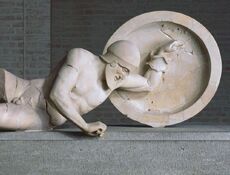
Sculpture of a dying warrior from a pediment of the temple to the goddess Aphaia on the island of Aigina.
Formally, the story ends here, for what followed was implicit in the material and psychological damage the leading Greek cities had done to one another in these bitter years. Athens was broken, bankrupt, bitter, and filled with widows; and women who would never marry because so many men had died. The city was still suffering from the political fallout caused by the Thirty. In 399 BC, the Athenians put the philosopher Socrates on trial for vague anti-Athenian wrongdoings. After his conviction, he spent his last days in prison, where his friends and followers offered to help him escape and flee Athens; something many Athenians expected. But Socrates refused on principle, and died, in accordance with his sentence, by drinking poison hemlock. Sparta, the nominal victor, was little better off. Planting and harvesting had been thrown entirely off schedule. Thousands of Spartans, despairing of feeding themselves at home, became foreign mercenaries instead. One of them, Xenophon (d. 354 BC), has become famous for his written work Anabasis ("the march up"), detailing the desperate struggle homewards of ten-thousand Greek mercenaries from a defeat in Persia. Meanwhile, the Spartan king Agesilaus II (d. 360 BC) had rethought the deal with Persia. The Spartans had promised to give up the Ionian cities; instead, Agesilaus installed Spartan governors and garrisons in these cities. This was blatant empire-building, and the other Greek cities were not in the mood to tolerate it. Thirty years of fighting had barely ended, when Corinth, Thebes, Athens, and Argos banded together, with what was left of their armies, to force Sparta to give up her claims; the Corinthian War (395–387 BC). After three years of pointless fighting, Sparta backed-down; not to the Greeks, but to the Persians. They offered to give up the Ionian cities after all, in return for Persian support in the war. This forced the anti-Spartan alliance to seek peace. The so-called King's Peace, dictated by the Persian king Artaxerxes II, restored Persian control over all of Ionia, and declared that all other Greek cities would be "autonomous" (in effect prohibiting them from forming leagues or alliances). Sparta was to be the guardian and enforcer of the peace, The effects was a brief Spartan hegemony over Greece. Thebes was the main loser of the war, as its Boeotian League was disbanded. Peace did not last long: war between Sparta and a resentful Thebes resumed in 378 BC. In 371 BC, to the astonishment of Greece, the Spartan army was defeated on the fields of Leuctra. That marked something of an epoch in Greek history. Militarily, the battle was innovative in several ways; the sheer professionalism of the Theban elite force, the Sacred Band, composed of 150 pairs of male lovers; and the brilliant tactics by Theban general Epaminondas (d. 362 BC), such as an oblique line of attack (refusing one flank) to counter the Spartan numerical advantage. Politically, Spartan hegemony was not replaced by Theban, but by a patchwork of new confederations; one was even set-up in the Peloponnese as a counterweight to Sparta. After the Battle of Leuctra, the history of Greece becomes less interesting; and also less important. What remains important is the history of Greek civilization, and the shape of that, ironically, was to be determined by a kingdom in northern Greece that some said was not Greek at all: Macedonia.
Greek Achievement[]
Such events would be tragic in the history of any nation. The passage from the glorious days of the struggle against the Persians, to Persia's almost effortless regaining of all her losses thanks to Greek division, is a rounded drama which always grips the imagination. Behind the jumble of battles, intrigues, disasters, and glory still lies an intriguing and insoluble puzzle: was there a real opportunity squandered after Plataea and Mycale, or was this long anti-climax simply inevitable? But the fundamental explanation why these few years should fascinate us is that, during them, there came to fruition the greatest cultural achievements the world had yet seen. In the end, the Ancient Greeks are remembered as poets and philosophers, scientists and artists; it is an achievement of the mind that constitutes their major claim on our attention.

Nineteenth-century painting depicting the Athenian politician Pericles delivering one of his famous funeral oration in front of the Ekklesia ("Assembly"), which any citizen of Athens could attend, and it was his duty to do so.
We have already touched upon Athenian democracy. Attacks on it began in early times, and have continued ever since, embodying as much historical misrepresentation as have over-zealous idealizations of that same institutions. With the benefit of hindsight, Athenian democracy looks disastrously unsuccessful. If the fact that only a small élite took part in civic life is placed in the scale, then case against it seems heavy; women, landless poor, and slaves were excluded from citizenship. Anachronistic and invalid comparisons are too easy; Athens is not to be compared with democratic ideals still imperfectly realized in modern times, but with her contemporaries. More Athenians were engaged in self-government than was the case in any other state. Men of modest means, who could not have contemplated office elsewhere, listened to thoughtful arguments, weighed them seriously, and took responsible decisions. Athenian democracy, more than any other institution, brought about the liberation of men from the world of god-given rulers. Like any political system, Athenian politics may not be judged by its errors, vanities, and misjudgements, but by its working at its best; under the leadership of Pericles, it was outstanding. Athens left to posterity the myth of individual responsibility for one's own political fate. We need myths in politics, and have yet to find a better one. When all is said, Athenian democracy must be respected above all for what it cradled. The art of Classical Greece set the canons of beauty in many of the arts for two-thousand years. Though many of the greatest Greeks were not Athenians, and many Greeks rejected the Athenians’ claims to cultural superiority, in the arts, Athens' primacy was recognised at the time. In the West, the architecture and sculpture of the Romans was largely derived from Greek models. In the East, Alexander the Great's conquests initiated several centuries of exchange between Greek, Near Eastern, and Indian cultures; one movements, Greco-Buddhist art, had ramifications as far as Japan. During the Renaissance, the Classical tradition derived from Greece inspired generations of European artists.
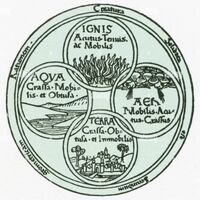
The Greek theory of the four basic elements - air, water, earth, fire - which combined in different proportions in all matter. It illustrates the deductive bias of Greek thought and its characteristic weakness; the urge to set out a plausible theory without submitting it to experimental test.
The achievements of Greek thought are too immense and varied a subject to summarize in a few paragraphs. But the central theme is a growing confidence in rational inquiry; that a coherent and logical explanation of things could be found, that the world did not ultimately rest upon the arbitrary fiat of gods. This was not, of course, an attitude grasped by all Greeks, or even by most. It was an attitude that had to make its way in a world permeated with popular superstition and orthodox piety. Nevertheless, it was a revolutionary idea. According to the Greeks themselves, the process of replacing supernatural notions of the world, with one governed by laws of nature began in Ionia; no doubt a Near Eastern background was important in getting things started. Thales of Miletus (d. 548), regarded by Aristotle as the first great Greek thinker, was able build on Babylonian and Egyptian astronomical knowledge, allowing him to predict solar eclipse of 28 May 585 BC. Thales' pupil, Anaximander (d. 546 BC), went on to argue that, since human babies are helpless at birth, if the first human somehow appeared on earth as an infant, it would not have survived; an early step towards the concept of evolution. Xenophanes (d. 470 BC), another Ionian, perceptively said, "If the ox could paint a picture of god, it would look like an ox". But, in the end, the achievements of Greek thought involved scores of thinkers from across the whole Mediterranean settled by Greeks.
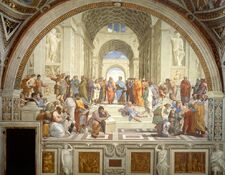
Raphael's masterpiece The School of Athens, depicting Aristotle and Plato as the central figures, with nearly every Greek philosopher found somewhere in the painting. Aristotle, like Plato, is one of the most influential people who ever lived.
Perhaps the single greatest triumph of Greek thought was in the field of mathematics, establishing most of the arithmetic and geometry which served western civilization down to the seventeenth century AD. Every schoolboy still knows the names of Pythagoras (d. 495 BC), Euclid (d. 250 BC), and Archimedes (d. 212 BC). In astronomy, the Greeks often pushed up to the limits of existing technical skills, and could not be expected to go beyond them; further progress had to await better instrumentation. Eratosthenes of Cyrene (d. 195 BC) was the first man to calculate the circumference of the Earth; Heraclides Ponticus (d. 310 BC) proposed that the Earth rotates on its axis; and Aristarchus of Samos (d. 230 BC) got so far as to propose that the Earth revolved around the Sun (though his views were set aside by contemporaries and posterity for the geocentric theory of Aristotle and Ptolemy). In medicine, Hippocrates (d. 370 BC) is traditionally regarded as the "father of medicine", while the later Galen (d. 216 AD) summarized and synthesized the work of his predecessors; his view remained largely unchallenged until the sixteenth century. Greek philosophy is strongly associated with Athens, because philosophical discussion has been shaped more by Plato (d. 348 BC) and his pupil Aristotle (d. 322 BC) than by any other two men. Disillusioned by the death of Socrates, Plato turned away from the world of practical politics, towards an idealist approach to ethical questions. The Good, he thought, was discoverable by enquiry; Truth, Beauty, Justice were other "changeless realities" which were hidden from us by the senses, but accessible to the soul by the use of reason. This idea had a significance going far beyond technical philosophy. In it can be traced a familiar later idea, that man is irreconcilably divided between the soul, of divine origin, and the body which imprisons it; an idea which was to pass into Christianity with enormous effect. In his most ambitious work, The Republic, Plato begins by asking "What is Justice?", and goes on to imagine a utopian state ruled by the wise in which justice prevails. His arguments were to provoke centuries of discussion; as one twentieth-century philosopher put it, "All Western philosophy is but a series of footnotes to Plato". The Academy of Athens, founded by Plato, has a good to be the world's first university. From it emerged Aristotle, a thinker more comprehensive and balanced, if less adventurous, than he. Aristotle was so rich a thinker, and interested in so many fields, that his historical influence is hard to delimit. What he wrote provided a framework for the discussion of philosophy, biology, physics, mathematics, logic, literary criticism, aesthetics, psychology, ethics and politics for two-thousand years. It was a vast achievement, different in kind but no less important than that of Plato. Aristotle was also a great collector and classifier of facts, anticipating another Greek invention, that of history. Herodotus (d. 425 BC) has reasonably been called the "father of history". His motivation was a wish to understand a near-contemporary event, the great struggle between Greece and Persia. The result was his Histories, a remarkable work based on a mass of eye-witness accounts and available chronicles. Herodotus' great successor, Thucydides (d. 400 BC), took a more rigorous approach, less credulous of witnesses, and more striking in his historical analysis, His subject was even more contemporary, the Peloponnesian War, which reflected his own desire to explain the causes which had brought his city of Athens, and Greece, to their dreadful plight. History was itself evidence of a whole range of literature created by the Greeks. As Homer shows, the earliest Greek literature was lyrical poetry, performed at religious festivals, and closely linked with moral teaching; if the works were written down, this was merely to preserve them, and perform them in a consistent manner. The origins of Greek theatre lie in the revels of the devotees of Dionysus, god of fertility and wine. In keeping with the god's special interests, his festivals were exciting occasions, with poetry accompanies by choral singing, dance, and mimes. In 535 BC, we are told, a priest named Thespis introduced a new element; he performed the individual characters in the story, distinguishing between them with the aid of masks. In effect, Thespis was the first actor, from which we get the word "thespian". Further innovation and more actors followed, and, within a century, we have reached the full, mature theatre of the three great tragic playwrights; Aeschylus, Sophocles and Euripides. In the early fifth century BC, the scope of theatre was broadening; drama and comedy developed as forms in their own right. Western theatre comes, in large measure, from the three genres of Greek theatre.
Greek culture still had a long life ahead at the end of Classical Greece, for Greek was to become the lingua franca of all the Near East, as well as much of the Mediterranean, thanks to Alexander the Great Then in the second century BC, Roman expansion made Greece teacher of Europe. It has been said that Greek thought actually came in the end to stand in the way of scientific progress. since their ideas were turned into dogmas, and, such was the reputation of Plato and Aristotle, that nobody could challenge them. The classical four elements of matter (water, fire, earth, air), the four humors of the body (blood, yellow bile, black bile, phlegm), and the geocentric model of the universe all illustrate the characteristic weakness of Greece science; an over-emphasis on logic and abstract deduction, rather than the observation. Greek thought arose from its own dynamism, and did not always lead to a greater understanding of nature, but sometimes to dead ends, blind alleys, and extravagant fantasies. But it was never monolithic, as it was to become in medieval times. So the ultimate fault is with later men.
Emergence of the Roman Republic[]
All around the Mediterranean shores, and across wide tracts of Europe, relics can still be seen of a great achievement; the empire of Rome. In some places – Rome itself, above all – they are very plentiful. To explain how they got there takes up a thousand years of history. If we no longer look back on the Romans as our ancestors often did, feeling dwarfed by them, we can still be puzzled and even amazed that men could do so much.
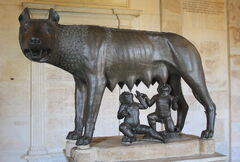
La Lupa Capitolina ("The Capitoline Wolf"), depicting a she-wolf suckling the mythical twin founders of Rome, Romulus and Remus. It was used as the emblem for the 1960 Summer Olympics in Rome, attesting to the enduring nature of the myth. Even the Roman historian Livy, our most important source for the early history of Rome, acknowledges that the story is a fable.
The Romans believed their city was founded by a certain Romulus and Remus, offspring of a princess of Alba Longa, one of the many Latin towns in the area south of the Tiber river. Their mother, Rhea Silvia, was the daughter of a king named Numitor, who claimed to be a descendant of the Trojan hero Aeneas. According to the legend, Aeneas led a group of refugees from the shattered ruins of Troy, across the Mediterranean Sea, to end up in Italy; thus giving the Romans a connection to the Greeks, they so admired. This Numitor had a wicked brother named Amulius, who mounted a coup that forced the king to flee alone into exile, unable to return to Alba Longa or to protect his family. Amulius then seized the throne, killed his brother's sons, and forced his daughter Rhea Silvia to become a priestess of the goddess Vesta (a Vestal Virgin), rendering her unable to have children on pain of death. Despite this precaution, Rhea Silvia became pregnant when, it is said, Mars, god of war, visited her in a sacred grove. Once born, Amulius ordered her twin sons drowned in the Tiber. As the river was in flood, the servant instead left the infants on the swollen riverbank to perish. In the most famous episode, the twins were discovered by a she-wolf, who suckled them, and, not long after, a shepherd found them; he named them Romulus and Remus, and raised them as his own. Year later, the adult twins got rid of their wicked great-uncle, and restored Numitor as king in Alba Longa. Now recognized as royal princes, the twins were suddenly seized by an urge to found a new settlement on the spot where they had been discovered as infants. Their grandfather approved; Alba Longa, having become over-crowded, was in need of a colony. But the sibling rivalry that had erupted between Numitor and Amulius, was now reborn in Romulus and Remus. They quarrelled over which of them should be the king, and decided to ask the gods for a sign; things went downhill from there. Romulus stationed himself on the Palatine hill, and Remus took the Aventine, from which to observe the auspices. Remus, the story goes, was the first to see a sign, six vultures; not longer after his brother saw twelve. Inevitably, both claimed to have won divine favour; one based on primacy of arrival, the other on number. Angry words ensued, followed all too soon by blows, and in the course of the affray Remus was killed. The newly founded settlement was thus named after Romulus, who fortified the Palatine Hill and made it the centre of his new city of Rome. The legendary founding date was 21 April 753 BC. We need not take this story seriously. Roman writers were magpies, collecting bits of other peoples’ stories for themselves; the tale of Romulus and Remus contains a mishmash of older Greek legends, not to mention hints of the Sargon-Moses trope. Perhaps the one historical echo we can dimly hear is a conflict between two related peoples. Archaeology tells us that Rome developed from the gradual union of two settlements, one on the Palatine hill, the other on the Esquiline. Perhaps one community did come down, like Romulus, to lay claim to the fertile Tiber plain to feed a growing population. Very likely the other group came from the nearby Sabine hills. According to legend, to grow his new settlement, Romulus opened its gates to men of all classes, including wanderers, fugitives, escaped slaves, and other cast-offs. The city became larger, but he had a problem; the Roman historian Livy remarks that Rome's greatness “seemed likely to last only for a single generation”, as there were almost no women. And it was so filled with undesirables that the neighbouring communities refused to send them wives. So Romulus threw a great festival of games for the god Neptune to attract the neighbouring people, including famously the Sabines. At the height of the festivities, Romulus gave a signal at which the Romans grabbed the Sabine women and fought off the Sabine men. These abducted women, the story goes, lost their resentment in course of time, because their new husbands "spoke honeyed words" to assuage their guilt over what they had done. But the outraged Sabine men marched on Rome in revenge. A massacre seemed likely to ensue, until the Sabine women flooded onto the battlefield, and put themselves between the two armies, They begged them all to cease, since either their husbands or their fathers would die. The battle thus came to an end, and the Sabines agreed to unite in one nation with the Romans. Romulus agreed to rule jointly with the Sabine king Tatius, but not for very long; Tatius died five years later, and was not replaced. This legends, however Greek-influenced, may well point to a real ancient Rome made up of two groups, Latins from Alba Longa, and immigrants from the Sabine hills. These people, of the same basic stock, were nevertheless so hostile to one another that they refused even to intermarry.

At the outset we should be clear that the location of Rome had nothing to do with a fortuitous encounter with a friendly wolf. The Tiber was a natural barrier across the land route which ran up and down the west coast of central Italy. The first place upstream at which it could be forded was about fifteen miles from the coast, where an island in the river was overlooked by several steep hills which provided readily defensible points for settlement. Sea-going vessels could make their way this far up the river, but marauding pirates would not risk venturing into such a likely trap. It was an obvious place for a prosperous settlement. But Rome not the only city growing on the fertile plains of the Italian peninsula. In the south, Greek merchants, firmly rooted into their trading post, had proved to the folks back at home that the Italian coast was a good place for Greek colonies. By 700 BC, cities here were as likely to be Greek as native. The settlers brought with them their Greek culture, their religious rites, and their tradition of independent city-states, which influenced the indigenous peoples. They were also influenced by native peoples, developing a distinctive culture which we call Magna Graecia (750-272 BC). Meanwhile, north of the Tiber lay another well-established people; the Etruscans. Despite much scholarly effort, the origin of the Etruscans remain a mystery. There has been much debate as to whether they were an indigenous Italian people, or immigrants from the Greek coast of Anatolia; the latter, if true, may offer an explanation for the Roman legend of Aeneas. In any event, by the middle of the seventh century BC, the Etrurians were the dominant force, both culturally and politically, in central Italy. Their towns stretched in a loose network of alliances up to the Arno river; the name "Tuscany" still recalls their prominence in the region. They brought iron-working to a high level and vigorously exploited the rich metal deposits of the Tuscan Apennines and of Elba island, off the coast. They grew rich through trade with the Celtic world to the north, and the Greeks to the south; and filled their large family tombs with imported luxuries. The Etruscans were literate, using an alphabet derived from Greek; despite the recognizable letters, hardly any of their writing can be understood. This means our understanding of their culture remains obscure, except that it was heavily influence by the Greeks; some historians argue that their culture was essentially “Hellenized”.
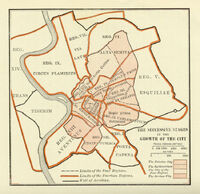
Illustration depicting the early growth of Rome during the kingdom.
For the first two centuries of Roman history, the city and its territory were ruled by kings. Little is certain about the Roman Kingdom (753–509 BC), as no records and few inscriptions survive; much was lost when the Gauls sacked the city in 390 BC. Accounts of the “Seven Kings of Rome”, written centuries later, are thought to be based on oral tradition, with a strong whiff of parables. Each king's reign is characterized by his personality, and credited with establishing a key Roman tradition or important building. After founding his city, Romulus (753–716 BC) was thought to have established many of Rome's oldest customs and institutions, as well as waging war against neighbours. The Etruscan city of Veii, nine miles up the Tiber and alarmed by its rising power, began raiding Roman territory; foreshadowing that city's role as the chief rival over the next three centuries. Although he was able to defeat Veii's army, Romulus found the city itself far too well-fortified to besiege. Etruscan hostility was not the only cloud on Romulus’ horizon during his forty-year reign. Even the semi-divine founder was no more able to rule autocratically a Greek king could. The Senate, a council of one hundred elders chosen from the leading families, kept tabs on royal power. These men were called Patres ("city fathers"), and their descendants became the "patricians". forming one of the two major social classes in Rome; the other being "plebeians", in other words commoners. There was also a popular assembly (the Curiate Assembly), but it had very little power. Accounts of the death of Romulus vary. In the mythological version, he mysteriously disappeared in a sudden and violent storm, raised to heaven by the god Mars. Other sources state that Romulus was murdered by resentful senators. Either way, the senators were not long in asserting their power to choose the new king. After much bickering between the Latins and the Sabines - no Sabine had held power since the death of Romulus’s co-ruler, decades before - a compromise was reached; the senators agreed to a Sabine king, as long as they could choose him. The Sabine they picked was Numa Pompilius (715–672 BC), a man renowned for wisdom and piety. Virtually all of Rome's most important religious institutions are attributed to him, including the Roman calendar, the Vestal Virgins, the cult of Jupiter (king of the gods), the cult of Mars, the cult of Quirinus (Romulus deified), and the office of pontifex maximus (chief high priest of Rome). He also constructed a new Temple of Janus (god of doorways and transitions), and, after establishing peace with Rome's neighbours, closed its doors for the first time; an enduring symbol of either peace or war. The temple doors remained closed for the rest of his reign. If Rome ever did experience a time of tranquillity, it was only temporary. The next king, Tullus Hostilius (672–640 BC), was as warlike as Romulus had been. His most significant campaign was the defeat of Alba Longa, the city which, together with Romulus, had once founded Rome as a colony. Alba Longa was completely destroyed, and its population integrated into Rome. His second alleged accomplishment was the construction of the original Senate House (the Curia Hostilia); which survived until 52 BC, when the supporters of the murdered demagogue Publius Clodius Pulcher used it as a funeral pyre. Tullus was followed by Ancus Marcius (640–616 BC), who combined the characteristics of his two predecessors. His most notable contribution to Rome was to introduce the solemn rituals (rerum repetitio) by which the Romans declared war. Rome could enjoy divine favour only if it waged "just" wars; that is, wars of self-defence. In later practice, this often meant that Rome manoeuvred other states into declaring war. Meanwhile, Tullus recognised that, for a city to truly prosper, they needed more than just military power. This is why he constructed the first bridge over the Tiber (the Pons Sublicius), allowing goods, people, and ideas to move more easily. He further strengthened Rome's position by encouraging the other Latin communities into trade agreements. Tullus also secured a valuable resource for the city by capturing the coastal salt pans.
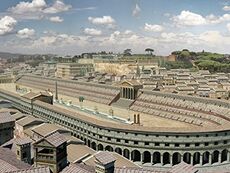
Illustration of the Circus Maximus, the first Roman chariot-racing stadium built under Tarquin the Elder. It started out as an underwhelming piece of land surrounded by wooden perimeter seating, but was built into a grand and beautiful stadium. In its fully developed form, over 150,000 spectators could accommodated, and it became the model for circuses throughout the Roman Empire.
Lucius Tarquinius Priscus, commonly known as Tarquin the Elder (616–578 BC), was the fifth king of Rome and the first of the so-called Etruscan dynasty. Tarquin came the Etruscan city Tarquinii, but was prohibited from holding political office there because of his "mixed blood"; his father was a Greek exile from Corinth. So he set his sights on control of Rome. After resettling in the city, he worked energetically (and scattered money around) until he gained favour with the king himself; Ancus Marcius, in his will, even appointed Tarquin guardian of his young sons. Upon the death of Ancus, Tarquin successfully persuaded the senators that he was the best choice for king. After nearly forty years on the throne, he was succeeded by his son-in-law, Servius Tullius (578–534 BC), another Etruscan. These two kings mask an historical truth; the city of Rome, warlike and pious by turns, was itself swallowed by the greater, stronger, and older culture to its north. Etruscan cities had already spread up all the way up to Po river valley. But Rome did not become part of some "Etruscan empire"; there was no empire, merely a set of Etruscan cities that shared a language and certain customs, that were sometimes allies, sometimes enemies. The Etruscan move into Rome was the addition of one more group into a city already occupied by several different groups; this one was more influential than all the rest. Tarquin the Elder is traditionally credited with constructing the Circus Maximus, the great chariot-racing stadium of Rome, which lay between the Palatine and Aventine hills. The famous mass entertainment venue started out as an underwhelming affair, but was later built into a grand and beautiful stadium. There, the king established a series of annual games; according to Livy, the first charioteers and jockeys were brought from Etruria. He also laid the foundations for the Temple of Jupiter on the Capitoline Hill; build the first stone walls around the city; cleared a space at the centre of the city to serve as a city gathering place, later known as the Forum; and began the digging of sewers to drain the city’s waste (a less dramatic but infinitely more useful accomplishment). Servius Tullius expanded the city to include the Quirinal, Viminal and Esquiline hills, and added the temples to Fortuna and Diana. These real structures were indeed built by Etruscans. Romans had little talent for building, but, in Etruria, excavation shows planned cities laid out in a grid, with standardized widths for main streets, the secondary roads that crossed them, and the minor roads that lay between; like the long-ago cities of Harappan India. In Rome itself, archaeology reveals that, around 650 BC, the wattle and daub huts in which most Romans lived began to be knocked down in favour of stone houses. The very material of Rome gained an Etruscan stamp. So was its monarchy. Tarquin the Elder introduced the Etruscan symbols of kingship: the gold crown, the purple robe, an ivory sceptre, and a carved wood throne. He was attended, wherever he went, by twelve bodyguards (the lictors), each wielding an axe bound in wooden rods (the fasces); an enduring symbol of magisterial power. More superficial but striking examples include the introduction of the toga (an Etruscan invention), the gladiatorial games, and the taking of auguries (reading omens from the behaviour of birds, or examination of their entrails). It was also through Etruscans that Rome first had direct access to the Greek culture. And Rome went on fighting. One by one, the Latin communities and persistent Sabines were defeated, and forced to acknowledge Rome's leadership. The Tarquins also warded off attacks from other Etruscan kings, who resented Rome's control of the important ford on the Tiber river. Livy tells the story of war after war; Rome against Collatia, Rome against Fidenae, Rome against a five-city coalition of Etruscans, Rome against Eretum: unending war. Tarquin the Elder celebrated his victories in the Etruscan fashion, by riding through the city on a golden chariot drawn by four horses, while wearing his full royal regalia; the first Roman to ever celebrate a Roman triumph.
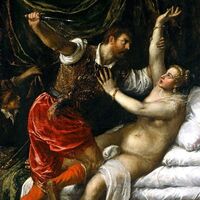
Sixteenth century depiction of the rape of Lucretia, which the sparked a political revolution in Rome. Modern historians regard these events as quasi-mythological detailing of an aristocratic coup, rather than a popular revolution. They fit a narrative of a personal vengeance against a tyrant leading to his overthrow, which was common among Greek cities.
The Roman historians depict the first six kings as benevolent and just rulers, but the last one as a stereotypical Greek "tyranny", in order to explain the overthrow of the monarchy. This was Servius Tullius’ nephew, Lucius Tarquinius Superbus, better known as Tarquin the Younger (534–509 BC), who, it is said, gained the throne through the murder of his predecessor. Tarquin the Younger secured Rome's position as head of the Latins by forming an Etruscan-style league (the Latin League). He also undertook a series of building projects, including completing the Temple of Jupiter, adding tiered seating to the Circus Maximus, and extending the sewer system. However, his reign is best remembered for the use of violence and intimidation to control Rome; a general disregard for the established tradition of consulting the Senate on all matters of public business; and angering the Roman populace with the pace and burden of his building work. All these of these were serious offences. But the last straw was the rape of Lucretia, a virtuous noblewoman, by one of the king's sons. Shamed, Lucretia took her own life. Her body lay in a public square, while her husband, Lucius Tarquinius Collatinus, shouted out to his countrymen to help him avenge his wife’s death. It did not take long for indignation at the rape by the son to morph into indignation over the tyranny of the father. The Roman senators, led by Lucius Junius Brutus, obtain the support of the people to expel the king and his family. Tarquin himself was outside Rome at the time, and returned to find the rebellion in full swing; “The city gates shut against him,” writes Livy, “and his exile decreed”. But he did not give up without a fight. Tarquin made an attempt to stage a counter-revolution in the city and, when that failed, joined forces with Lars Porsenna, king of the Etruscan city of Clusium, who marched on Rome; only to be defeated by a valiant defence of the newly liberated Romans. We hear, for example, of the heroic Horatius Cocles, who single-handedly defended the north bank of the Tiber long enough for his companions to destroy the bridge behind him. This narrative of the events, traditionally dated to 509 BC, provided later Romans with a satisfying patriotic story of despotism giving way to liberty. It is probably unhistorical, however, and merely a Roman adaptation of a well-known Greek story of a love affair in Athens that led to the murder of the tyrant’s brother and the tyrant’s eventual downfall. Even the date is suspect; patriotic historians likely shifted the year slightly to predate the establishment of Athenian democracy in 507 BC. Whatever the exact date, this was about the time at which Etruscan power, over-strained by struggles with the western Greeks and Carthaginians, began to decline. And they were just about to lose their grip on the Po river valley. At this time, Celtic civilization, whom the Romans knew as “Gauls”, was vibrant and in the process of military and territorial expansion. The invasions southwards into northern Italy, which began right around 500 BC, drove the Etruscans from their northern cities, and founded new ones; Milan, Verona, Trento, and Vicenza among them. As for Rome, it had been ruled by Etruscans since the accession of Tarquin the Elder a hundred years earlier. The expulsion of the younger Tarquin may have a historical base, but it is unlikely that the Romans suddenly realized the shortcomings of monarchy. Rather, the monarchy was incidentally ended through Rome's throwing off of Etruscan dominance.
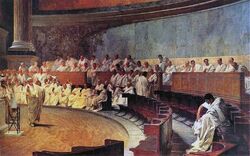
Nineteenth century fresco depicting a sitting of the Roman Senate. The constitutional theory was concisely expressed in the motto carried by the monuments and standards of Rome until well into imperial times: SPQR, the abbreviation of the Latin words for "the Roman Senate and People". Theoretically, ultimate sovereignty always rested with the people, though the actual working of the Republic was not as democratic as they appeared on the surface.
The end of the monarchy was also the birth of the Roman Republic (509–27 BC). For the rest of Roman history, rex ("king"), was a term of loathing in Roman politics, despite the fact that so many of Rome’s defining institutions had their origins in the regal period. There were any number of cases in the centuries that followed, when the accusation that a man was aiming at kingship brought a swift end to his political career. Even Lucretia’s unfortunate widow Collatinus, because he was a relative of Tarquin the Younger, was shortly sent into exile. As the tyrant fled, the story goes, Brutus and, before his exile, Collatinus, straight away became the leaders of the city. These two men were granted kinglike powers, presiding over politics at home and leading the army in war; but with a few key differences. They were elected entirely by popular vote, held power only for a single year, and each man had the ability to veto the decisions of his colleague. They were known at first as praetor, and later consuls, the highest office in Roman government; the term praetor came to be used for a junior official below the consuls. There were other early offices at the top of the political hierarchy, which further complicate the picture. First, the practical Romans created an emergency office called the dictatorship; a word without the decidedly negative modern connotations. In a military emergency, the consuls could pass power to a single man who would hold absolute power in order to deliver Rome from danger. Importantly, the dictatorship expired after six months. For nearly five hundred years Roman dictators never failed to lay down their power. Second, the king’s religious functions were henceforth performed by the pontifex maximus, who held office for life. Third, two censor, elected every five year, were responsible for registering citizens and assessing their proper "class", based on ancestry and wealth. They also had a vague responsibility for supervising public morality; which is the origin of the modern word "censorship". Finally, there were military tribunes, who acted as a mouthpiece for the army. Constitutional theory was concisely expressed in the motto carried by the monuments and standards of Rome until well into imperial times: SPQR, the abbreviation of the Latin words for "the Roman Senate and People". Theoretically, ultimate sovereignty always rested with the people, which acted through a complicated set of popular assemblies attended by all citizens; of course, not all inhabitants of Rome were citizens. This was similar to what went on in many Greek city-states. In practice the Senate wielded enormous power because of its collective prestige. This prestige derived from not only precedent and custom, but the senators' calibre; members were drawn from the richest and most powerful patrician families in Rome. Rarely did consuls pursue a policy without the Senate's deliberative input. The Senate kept careful and tight control over the popular assemblies. Each assembly was presided over by an elected magistrate, who made all decisions on matters of procedure and legality. As such, citizens had no power, other than to cast a vote. And while each man had one vote, he did so within a system of block voting that favoured wealthier voters over the poorer elements. The whole system was perfectly designed for a small number of patrician families to hold on to power.

The Conflict of the Orders was a protracted political struggle between a privileged, hereditary aristocreacy (patricians) and the rest (plebeians); how the concerted action of the Roman people wrung concessions from the political elite and secured full rights for all. This story adds up to one of the most radical and coherent manifestos of popular liberty to survive from the ancient world - far more radical than anything to survive from Athenian democracy. Most Greek writers, who had anything to say on the subject, were opposed to democracy and popular power.
The vast majority of Roman citizens were plebeians, commoners of various social degrees. They formed the backbone of the economy, as smallholding farmers, traders, artisans, and tenants. In wartime, every male citizen who owned property had to serve in the army if needed; their livelihood left abandoned. Unable to earn a sufficient income, many turned to the patricians for aid, which left them open to exploitation. It was only a few years after the Republic had been established, that the plebeians began objecting to their exclusion from political power. For the poorest, one of the few effective political tools was a withdrawal of labour; the first such "secession" occurred in 494 BC. As in Athens, at around the same time, the problem of debt had become acute. A plebian who had to borrow money in time of hardship had to pledge himself as security; if the money was not paid back, he and his family became slaves. In this way, the patricians were gaining not only land and wealth, but ownership of Roman citizens themselves, in increasing numbers. The plebians found it particularly galling that they often fell into debt as a result of having gone off on military service. Livy writes that an old soldier, once famous for his exploits, hobbled into the Forum. His clothes were dirty, his body pale and thin, his hair and beard unkempt. He was recognised, and more and more people gathered to hear him; “While I was on service,” the old man said, “during the Sabine war, my crops were ruined by enemy raids, and my cottage was burnt. Everything I had was taken. Then, when I was least able to do so, I was expected to pay taxes, and fell, consequently, into debt”. He then ripped his shirt apart and showed the whip-marks upon his back, given him by his wealthy master. The people were outraged, and uproar spread throughout Rome. Their only strength was that of numbers, and they used it; leaving the city en masse to the Sacred Mount, three miles outside the city. In Rome, the patrician and remaining plebians were thrown into panic; the city froze up, vulnerable to attack, its daily work undone. The Senate and consuls were finally spurred to negotiate a reconciliation. From now on, they would be joined in government by special magistrates called plebian tribunes, who would always be elected from the plebian ranks, and designed to protect their interests, with the power to veto any unfavourable legislation. Their person was sacrosanct, which is to say, immune from pressure or intimidation; within the city limits, not even a consul could lay a hand on them. This was only the first crisis of what is often now called the Conflict of the Orders (495-287 BC), in which the plebeians sought political equality with the elite, patrician class. Over the next half century, the jockeying for power between the classes threw into sharp relief Rome’s need for a written law code. Roman merchants, who had visited Athens, came back talking of the laws of Solon, which had been written in part to alleviate tension between aristocrats and democrats. So in 451 BC, a board of ten lawmakers (the Decemvirs) was appointed to draw up laws to govern Rome. The result is known as the Twelve Tables, from the twelve bronze tablets on which it was originally inscribed and displayed in the Forum. It contains the expected provisions concerning such matters as legal procedure, debt foreclosure, paternal authority, property rights, inheritance, and funerary regulations. Although the Tables were a step in the right direction, they were not without controversy; most infamously, "A person of patrician class shall not partake in marriage with a person of plebian class", reads Table XI. That particular law was finally repealed in 445 BC, after savage debate in the Senate; not everyone was convinced that Rome would prosper if the blood of nobles and commoners mingled. The plebian tribunes and Twelve Tables did not entirely soothe Rome’s internal strife, but managed to hold the population together long enough for the city to fix its gaze outwards.
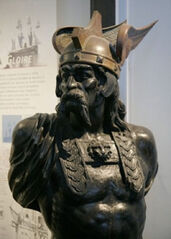
A figurehead of the Gallic chieftain Bremmus from the 19th-century French battleship of the same name. His sack of Rome set the scene for Roman anxieties about invaders from over the Alps (of whom Hannibal was the most dangerous), until Julius Caesar finally exorcised those demons 350 years later. It also explains why so little hard information survives for early Rome; it all went up in flames.
The expansion of Roman power started with a whimper rather than a bang. Roman historians tell stirring tales of heroic warfare on a grand scale, during the first century of the Republic. We hear, for example, of Lucius Quinctius Cincinnatus, who is supposed to have twice come from his plough to assume the dictatorship, and lead Rome out of dire straits, before nobly retiring straight back to his small farm, without seeking further political glory; more than two millennia later, he gave his name to the American city of Cincinnati. But the reality, so far as we can tell, was a much more modest continuation of clashes with neighbouring communities. That changed around 405 BC, when Rome began a long war with its old enemy, the Etruscan city of Veii; which had first attacked the Latin upstart back in the days of Romulus. It was written up as if it were an Italian equivalent of the Trojan War: the ten-year siege that it took to capture the city, equalling the ten-year siege of Troy; and the victorious Romans eventually popping up inside the city from a tunnel under the Temple of Juno, as the equivalent of the Trojan Horse. This was no clash of superpowers. Veii was a prosperous city, a little smaller than Rome, and just nine miles up the Tiber. Yet the consequences of Rome's victory were significant. The Gauls had been pushing south for a century or so. And now they were drawing closer and closer to Rome. But the Romans, busy annexing Veii and its surrounding territory, do not appear to have paid much attention. The army was just taking a breath when a message came from the Etruscan city of Clusium, who had back the hated king Tarquin a hundred years before. that a particularly warlike tribe had swept down from the Po river valley to raid Etruria. The danger must have been extreme for Clusium to appeal Rome for help. But the Gauls were an enemy that tended to unite old rivals. After the last decade of constant fighting, the Senate had no real aid to give, so instead sent three ambassadors to negotiate peace. This might have been a fruitful discussion, except that the Romans lost their tempers when the Gauls defied them. And the Gauls, led by a chieftain named Brennus, took this as a challenge; “They flamed into the uncontrollable anger, which is characteristic of their race," Livy writes, "and set forward, with terrible speed, on the path to Rome”. The Romans levied the largest yet assembled, plausibly estimated at 24,000 men, to face them at the Allia river, not far from the city. The Gauls must have been a fearsome sight, because the Romans apparently did little more than run away; and were pursued right into the city itself. Utterly defenceless, the whole population sought refuge on the steep Capitoline Hill. Later Roman historians gave extravagant coverage to the sack of Rome (390 BC), with various acts of heroism mitigating the widespread destruction. One poor man gave proof of plebeian piety, when he threw his wife and children out of his cart, in order to helped the Vestal Virgins carry their sacred relics to safety in the nearby town of Caere. Many elderly men decided to simply stay at home, and patiently await their fate. The Gauls burnt and killed until the city was reduced to ruins and ashes, but could not finish-off a spirited defence on the Capitoline. One tale describes how a sneak assault almost reached the summit, until the honking of the geese sacred to the goddess Juno alerted the guards. Presumably a long enough siege could have starved the Romans out, but, after seven months, both sides were reduced to famine. The Gauls, encamped on low ground, were also afflicted with pestilence. So they were ready to listen when the Romans made a proposition: to pay a thousand pounds of gold for a peaceful withdrawal. Livy memorably described the Gauls cheating by using unbalanced scales to weigh the gold. When the Romans protested, Brennus tossed his sword onto the scales, uttering words intolerable to the Roman ears, Vae victis! ("Woe to the vanquished!"). The Gauls took the ransom and retreated back to the north, where the mountainous cool was a little more congenial for them. The Romans emerged from the Capitoline to rebuild, hastily, in case the enemy should return. It answered the question of why the city of Rome, despite its world renown in the later Republic, was such an ill-planned rabbit warren. Yet it also opened a new chapter in Rome’s relations with the outside world.

